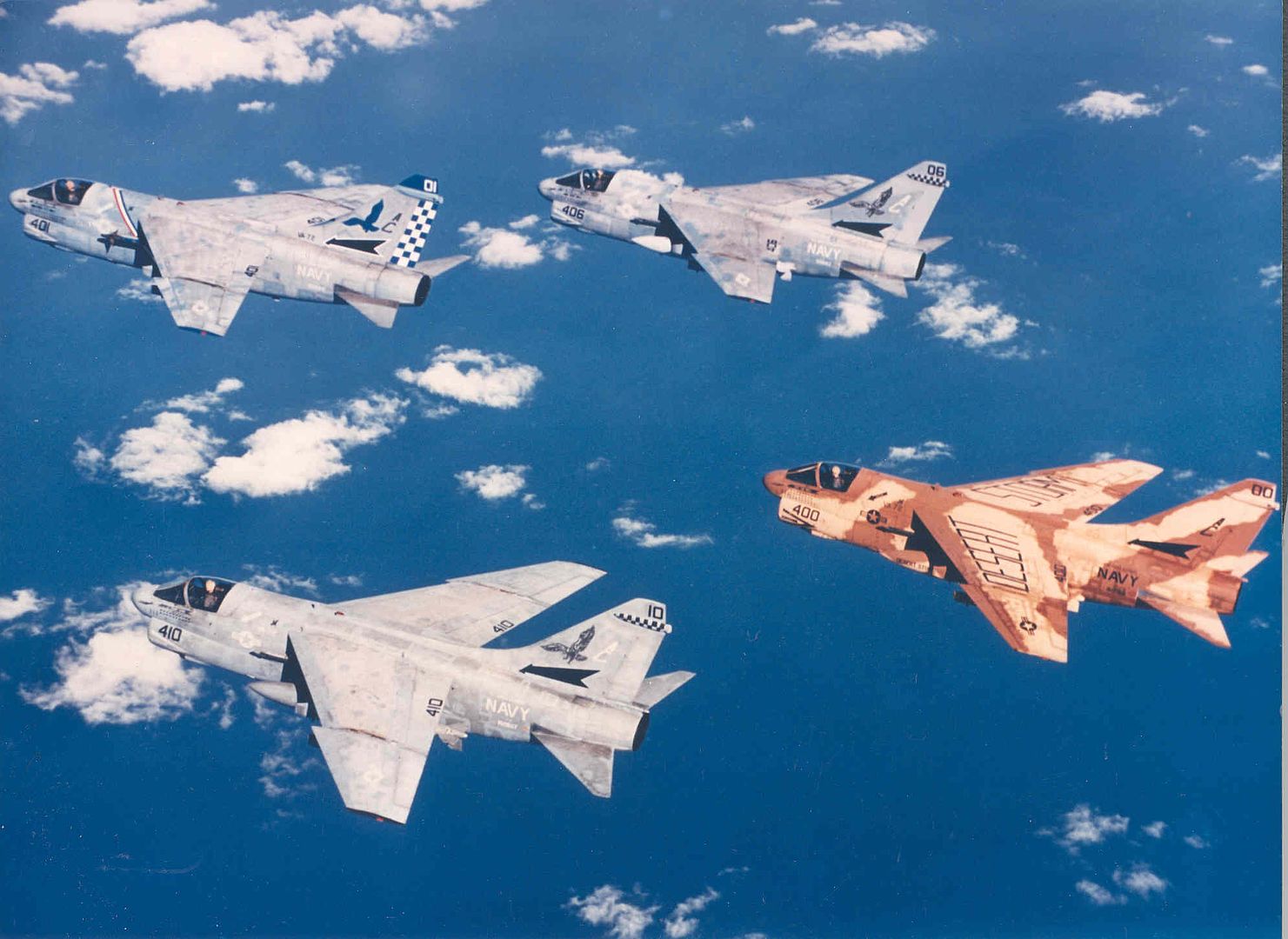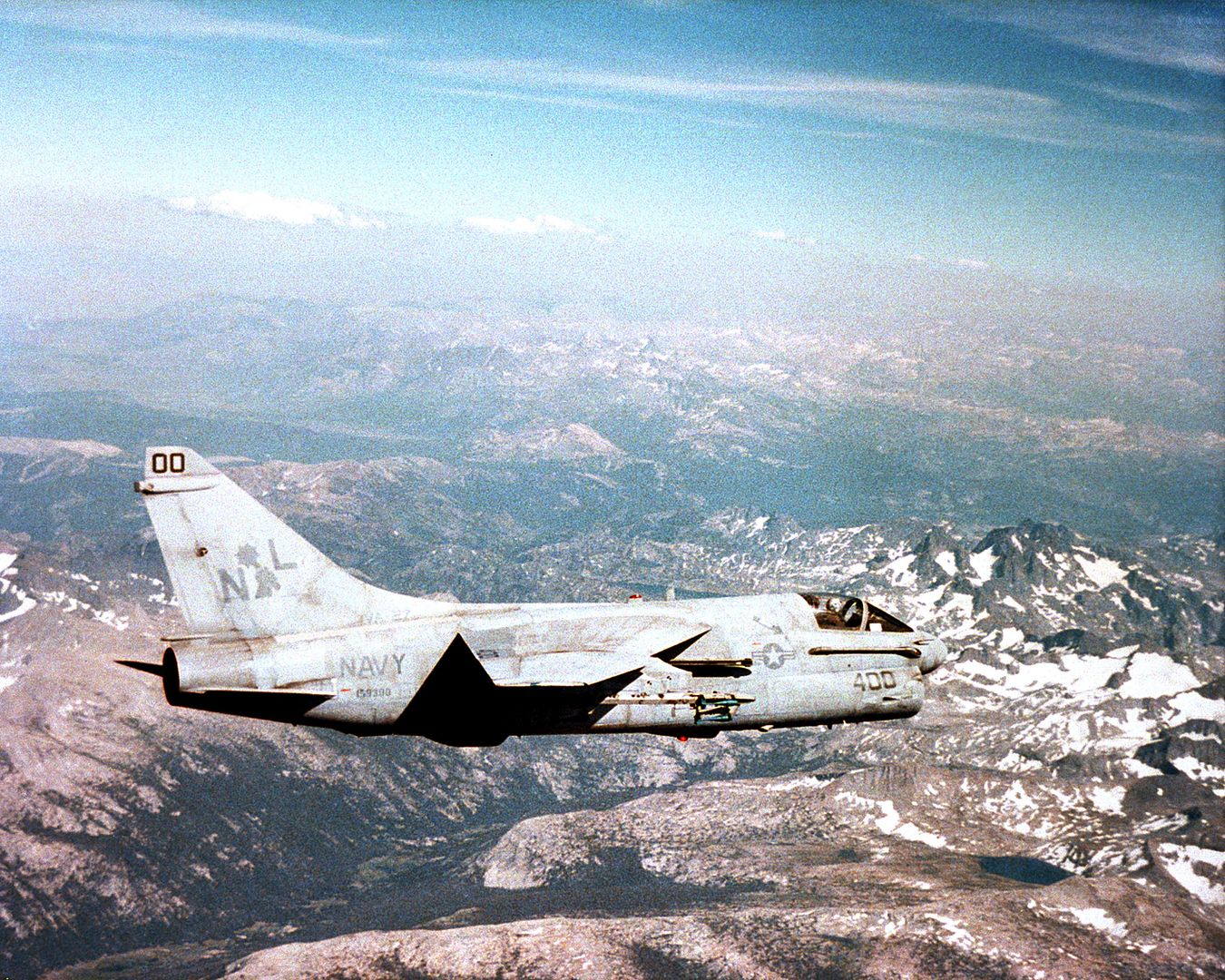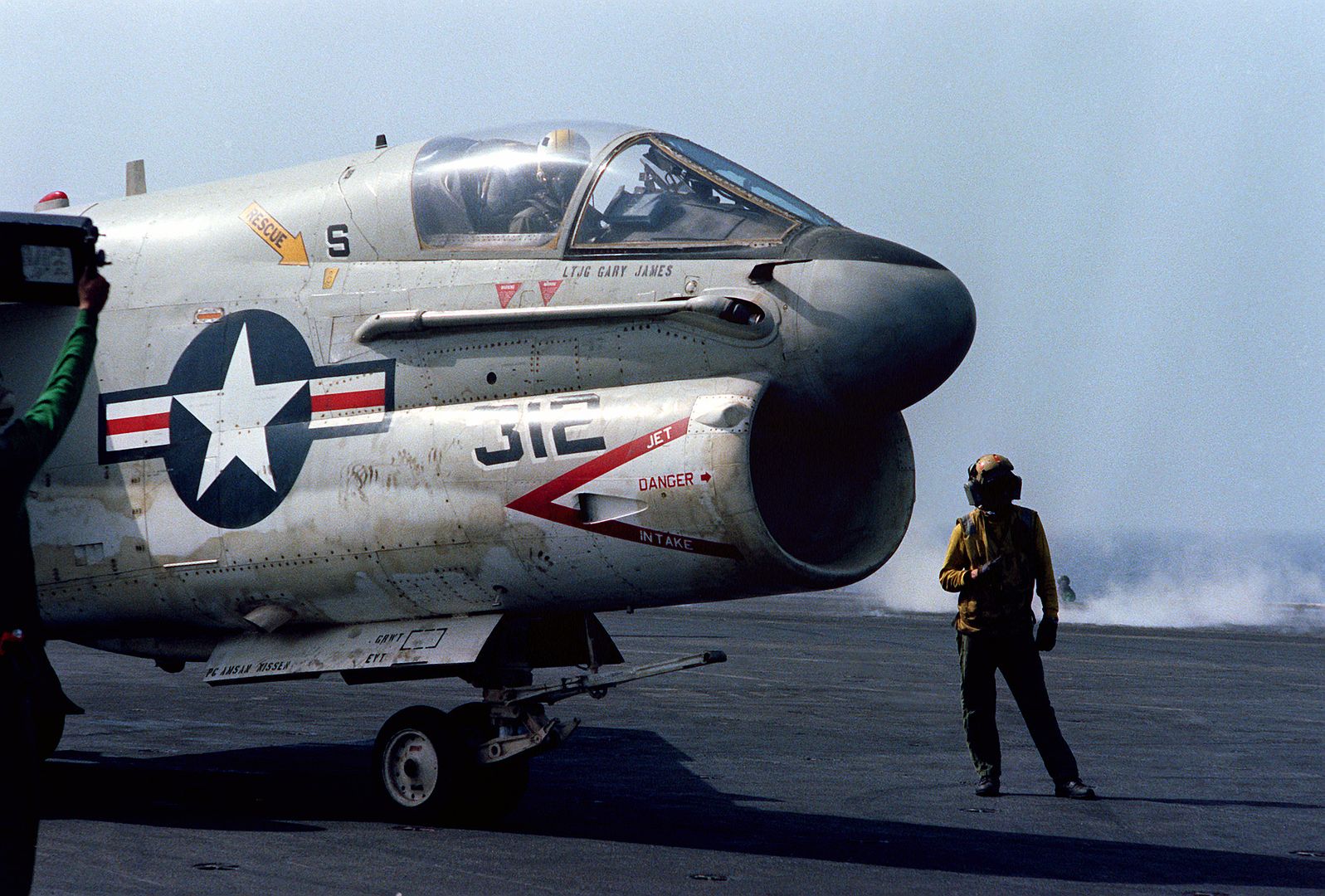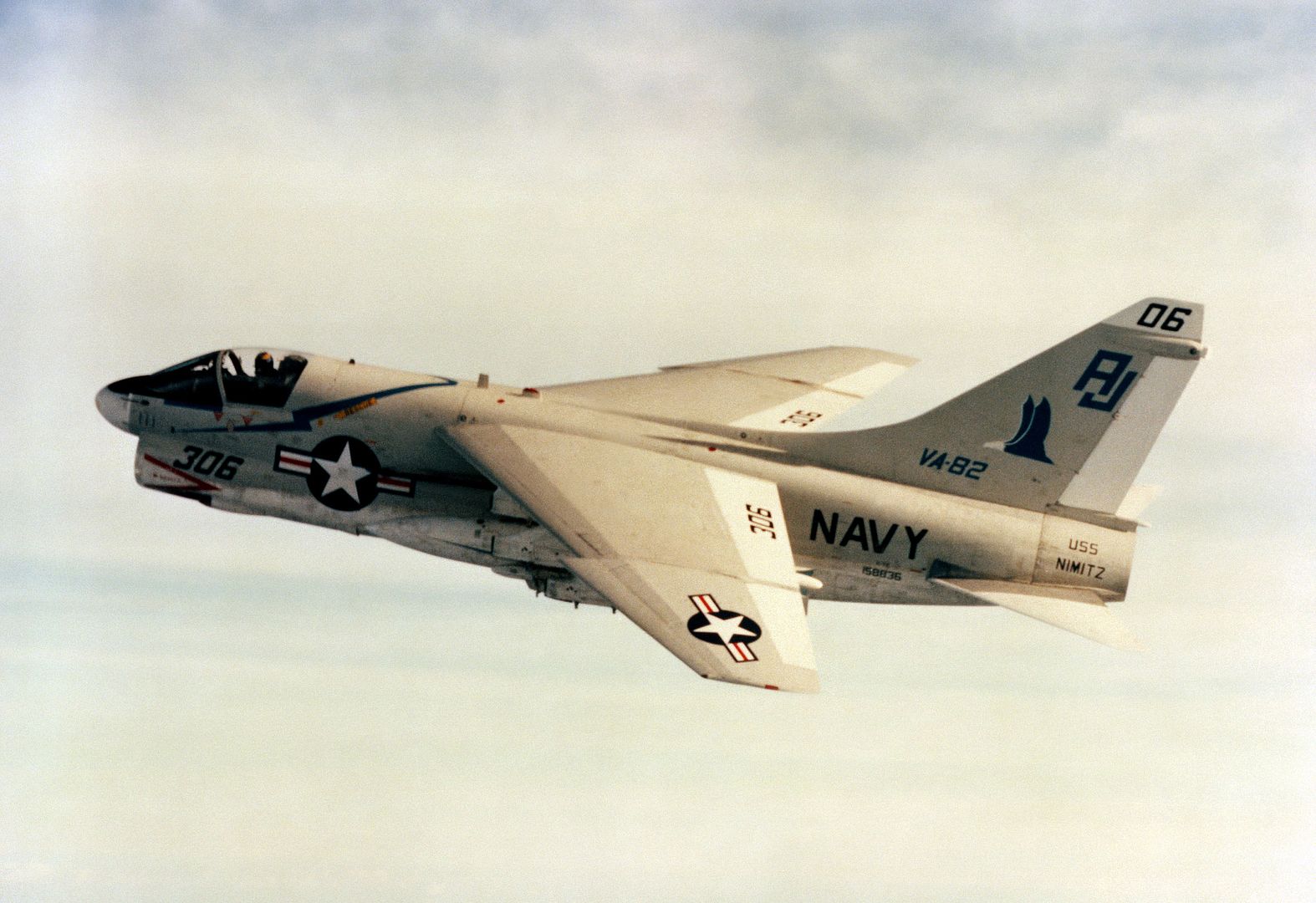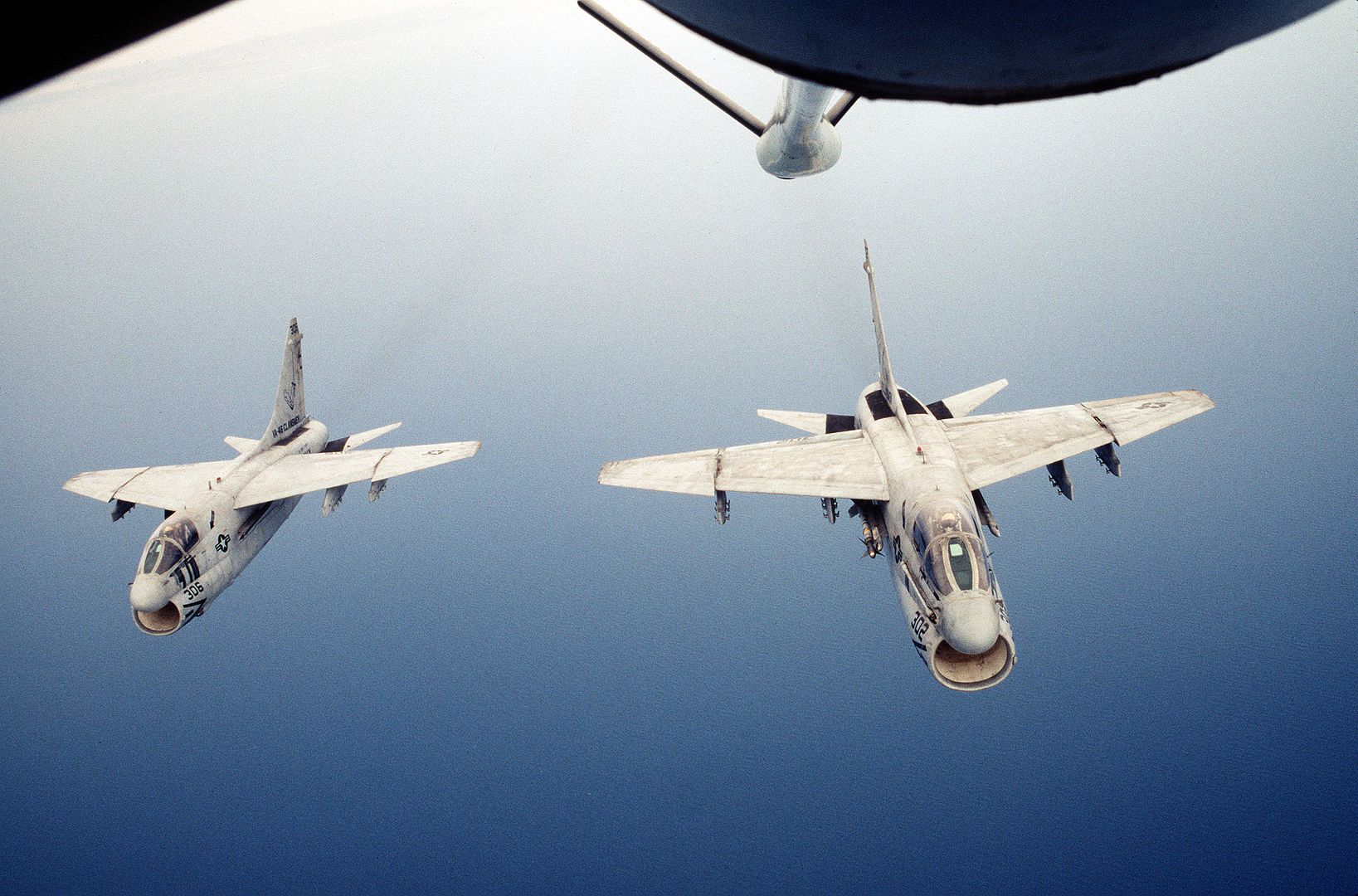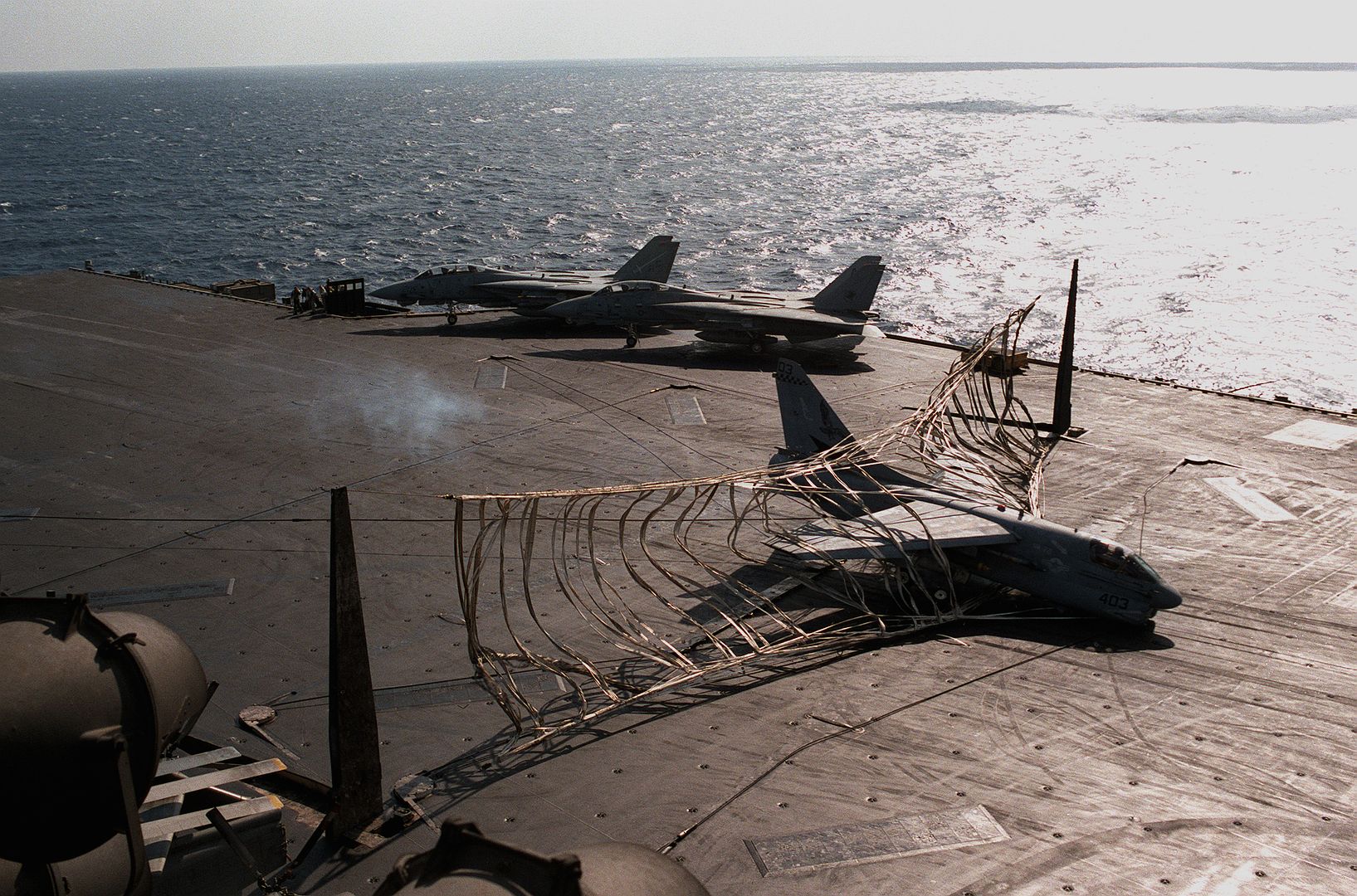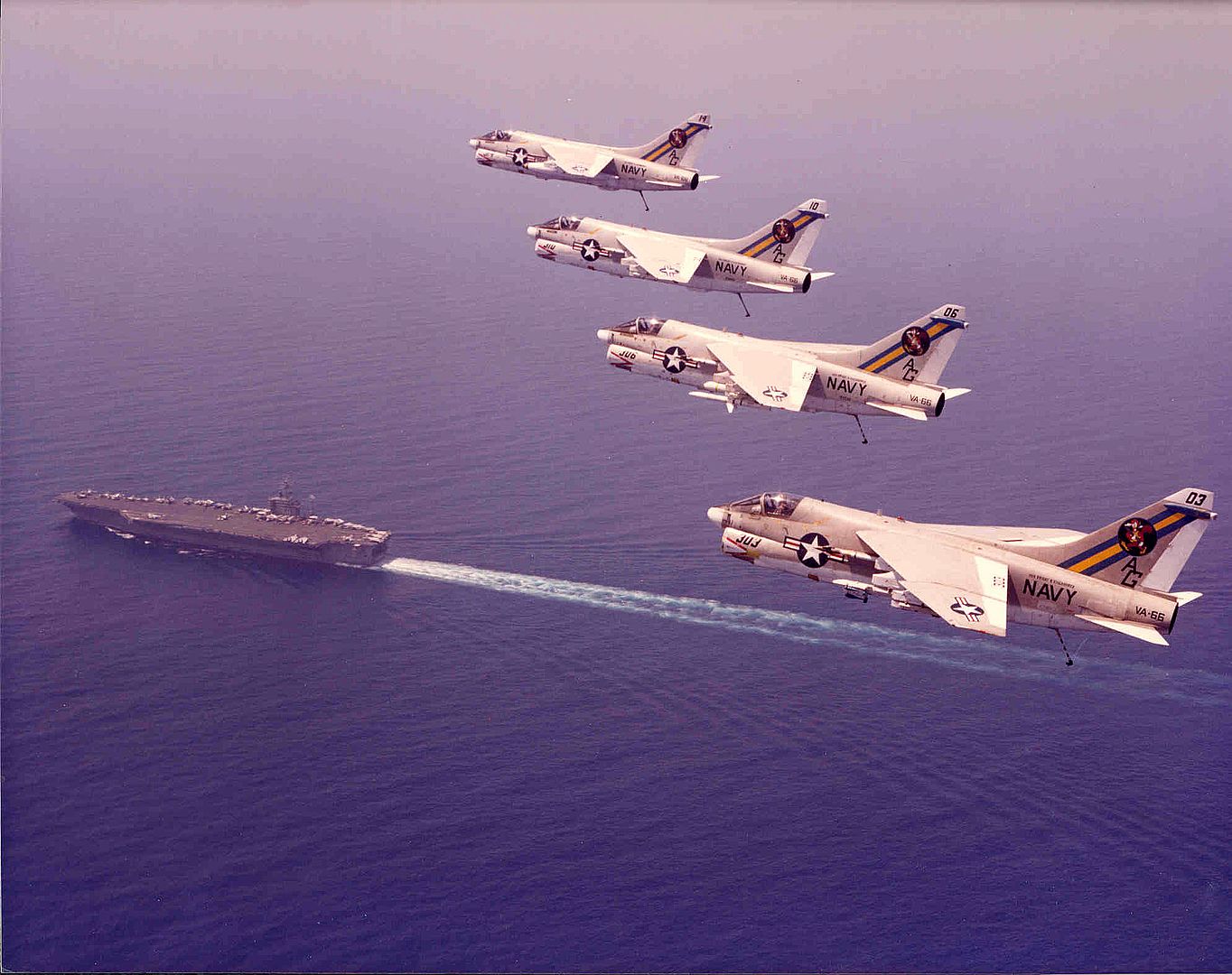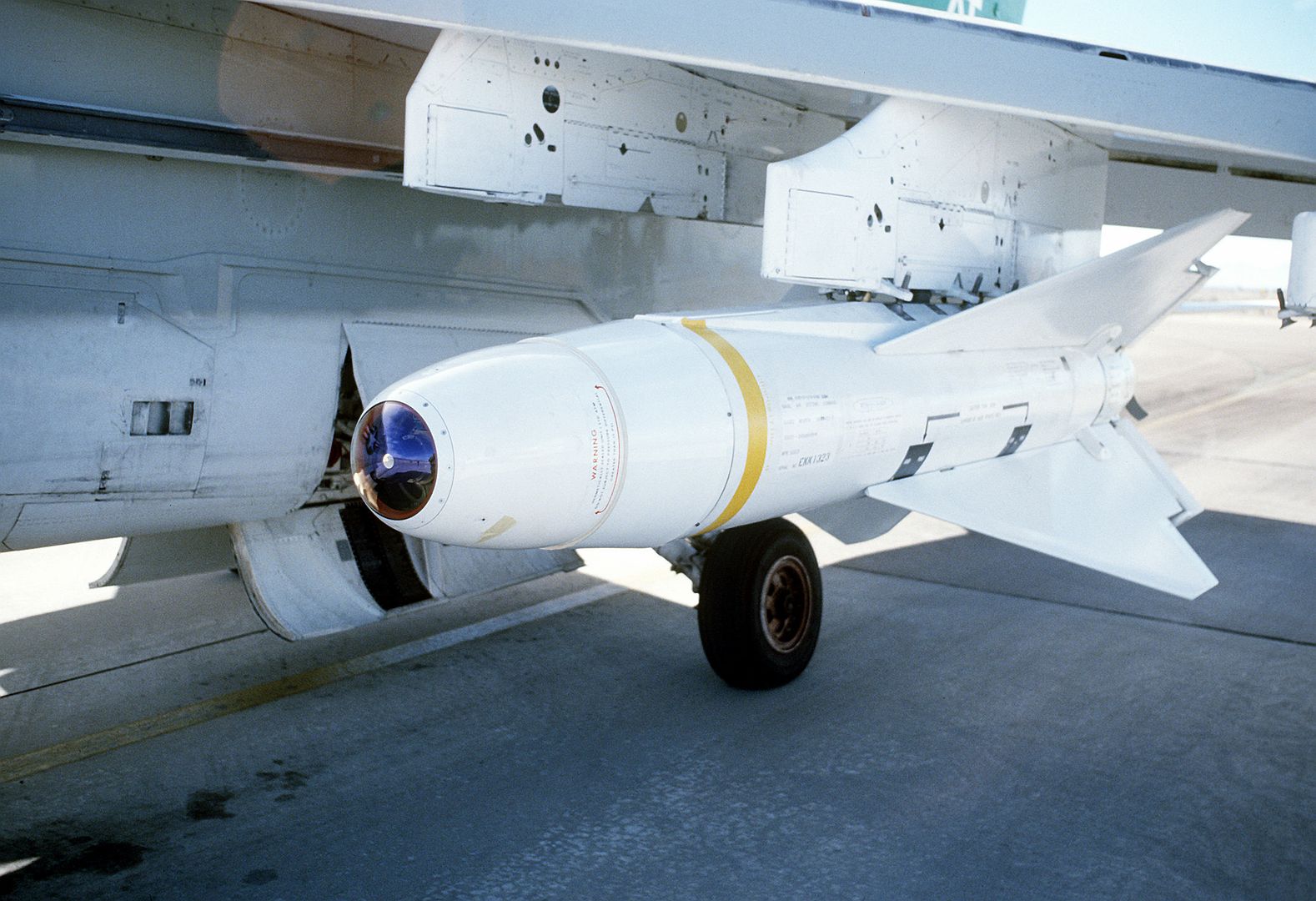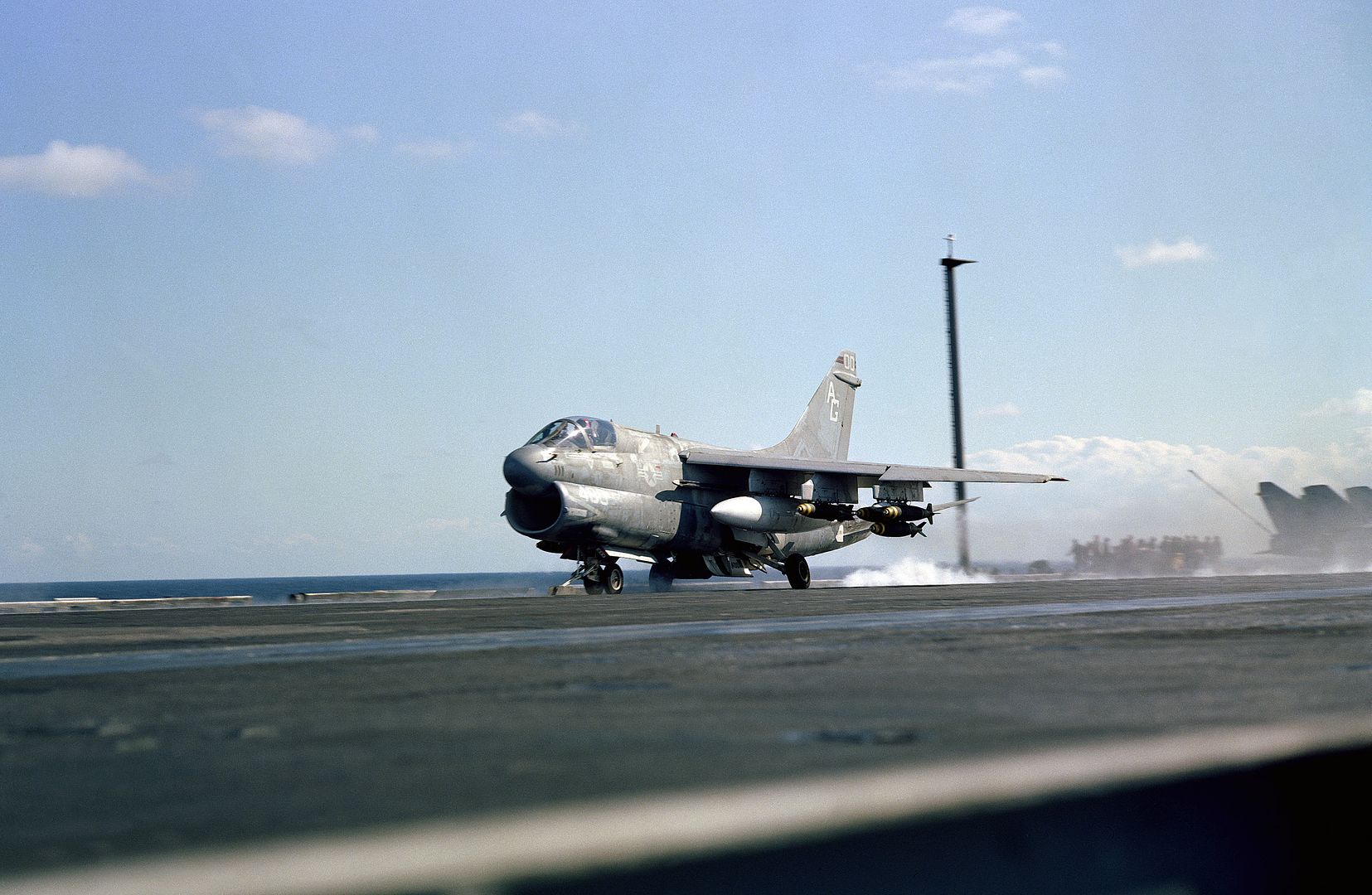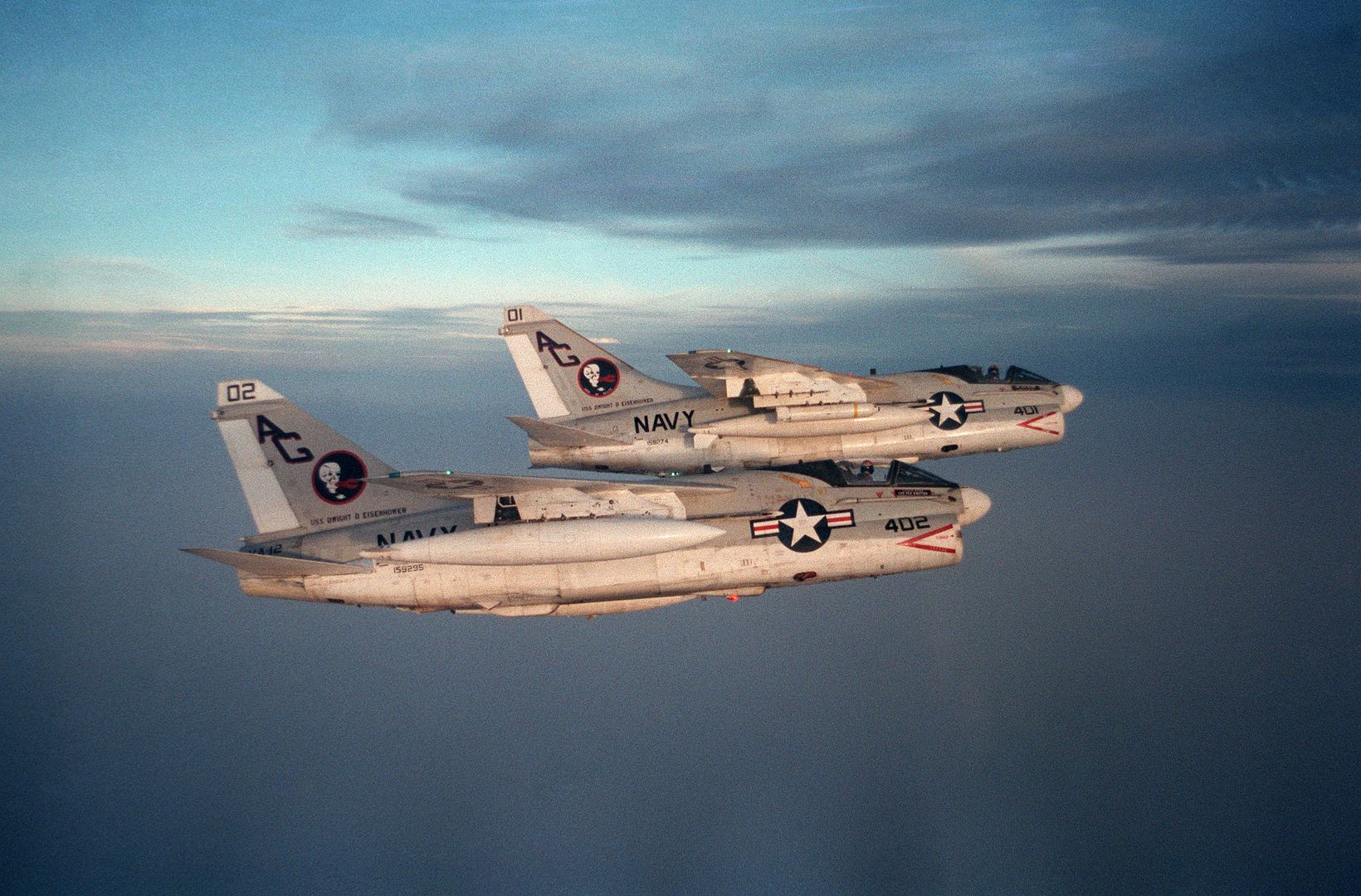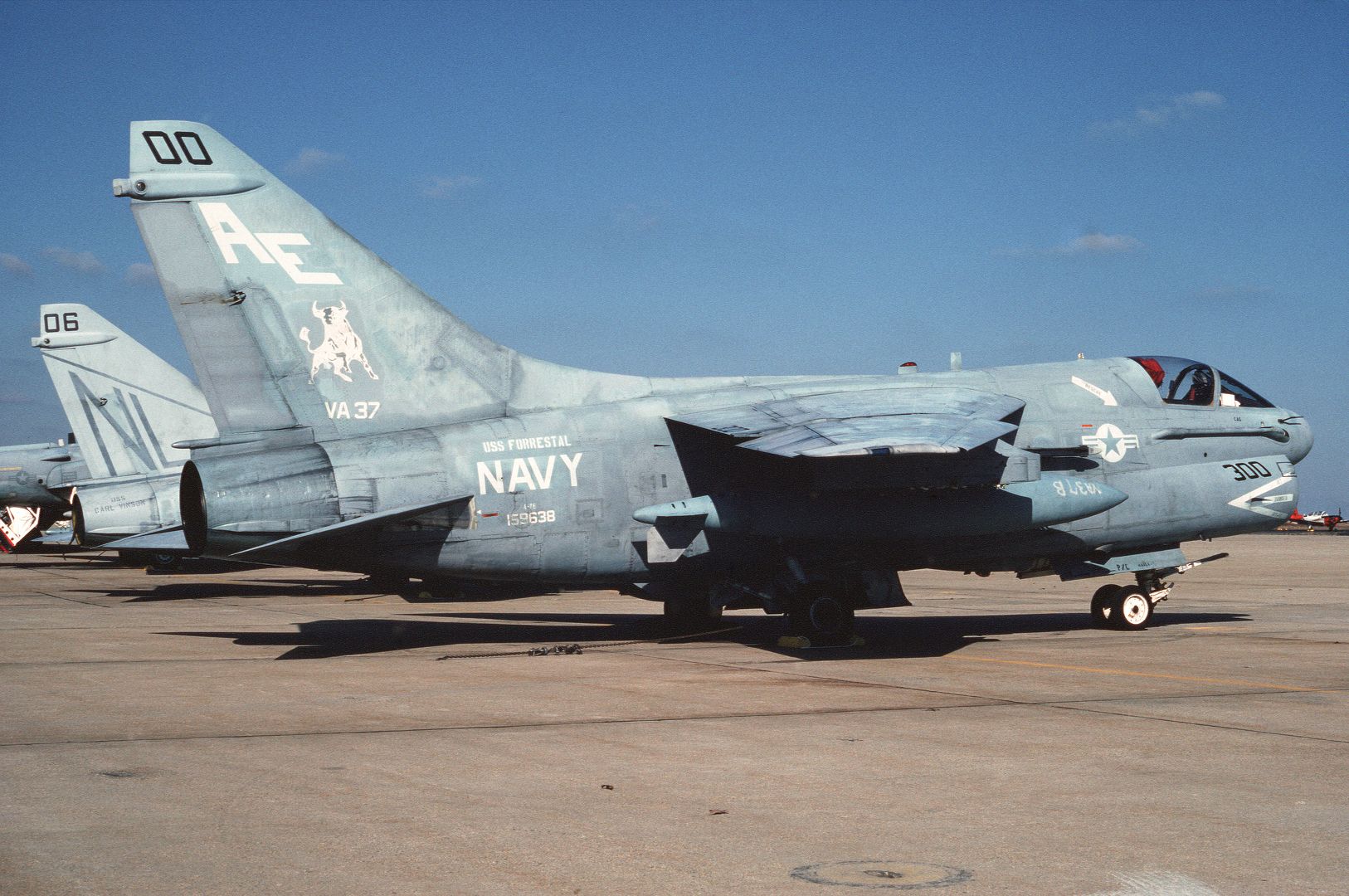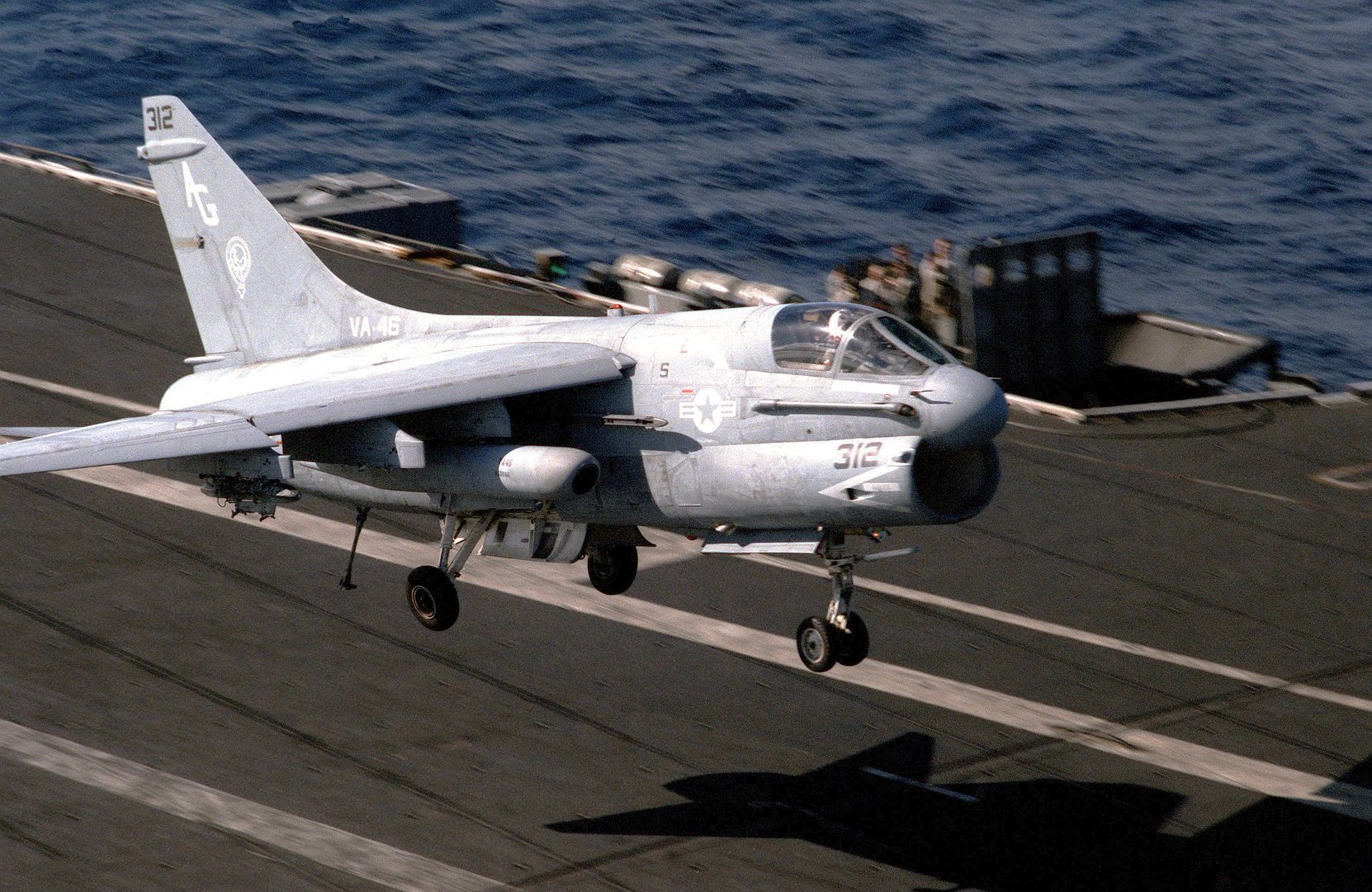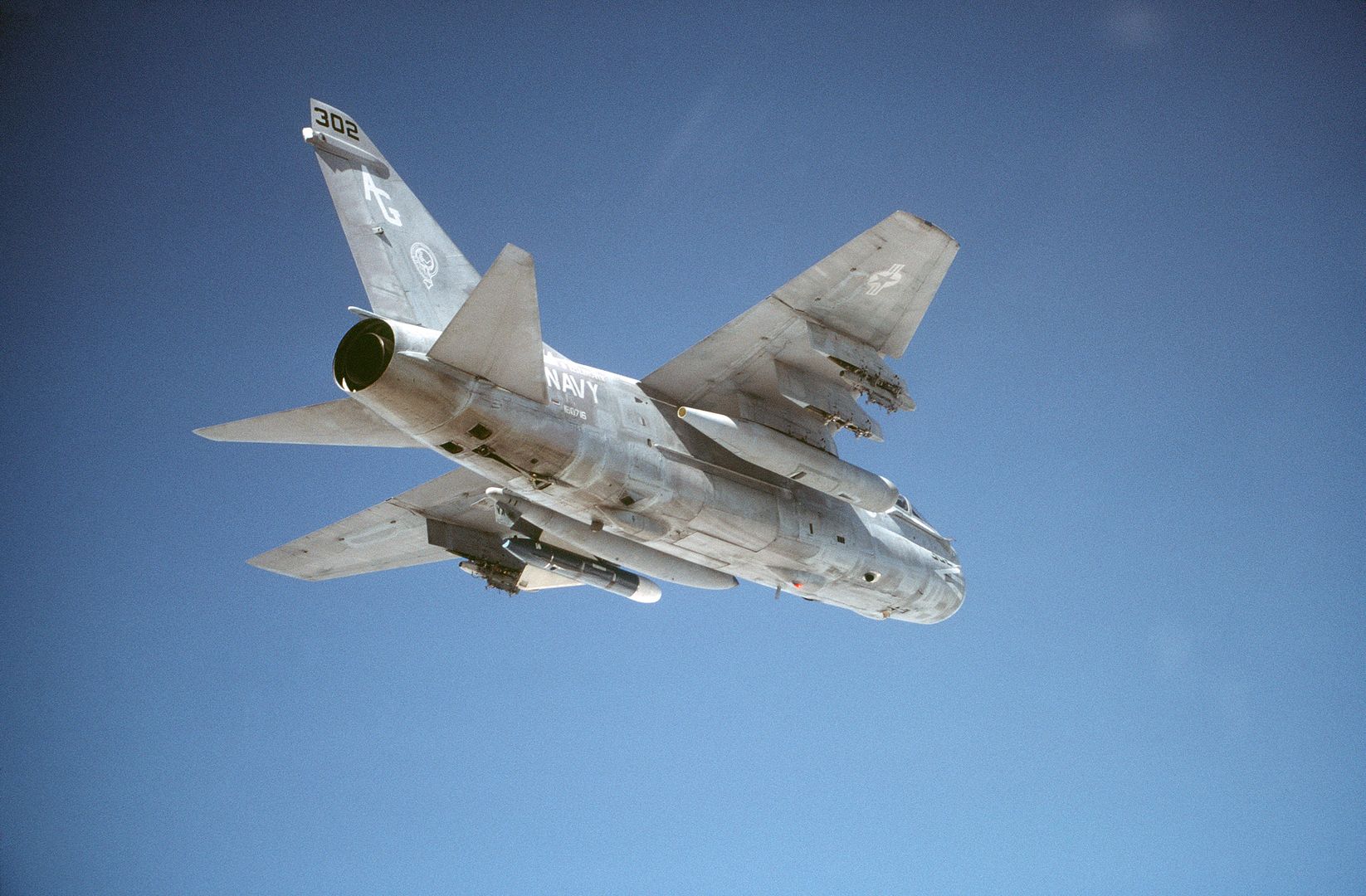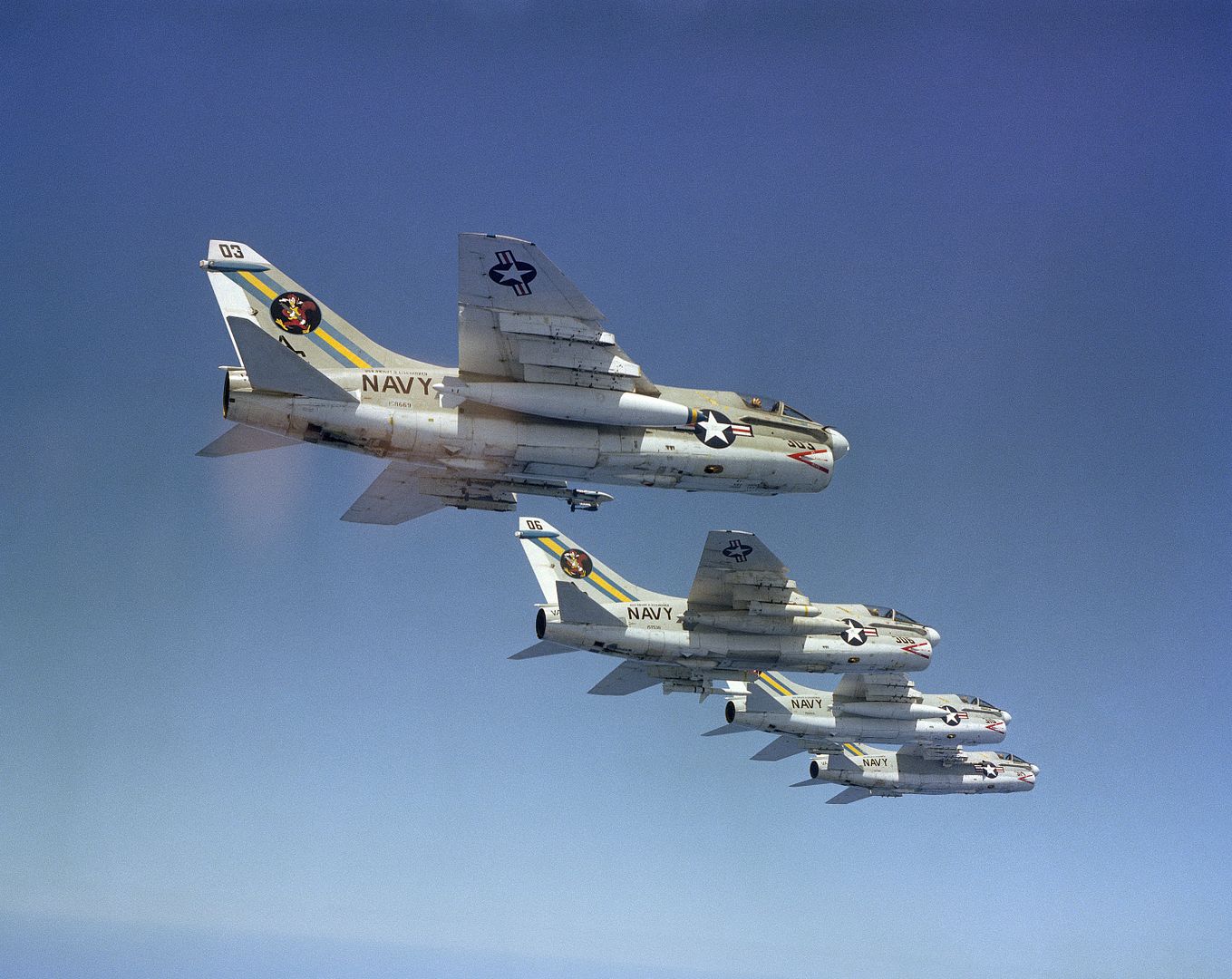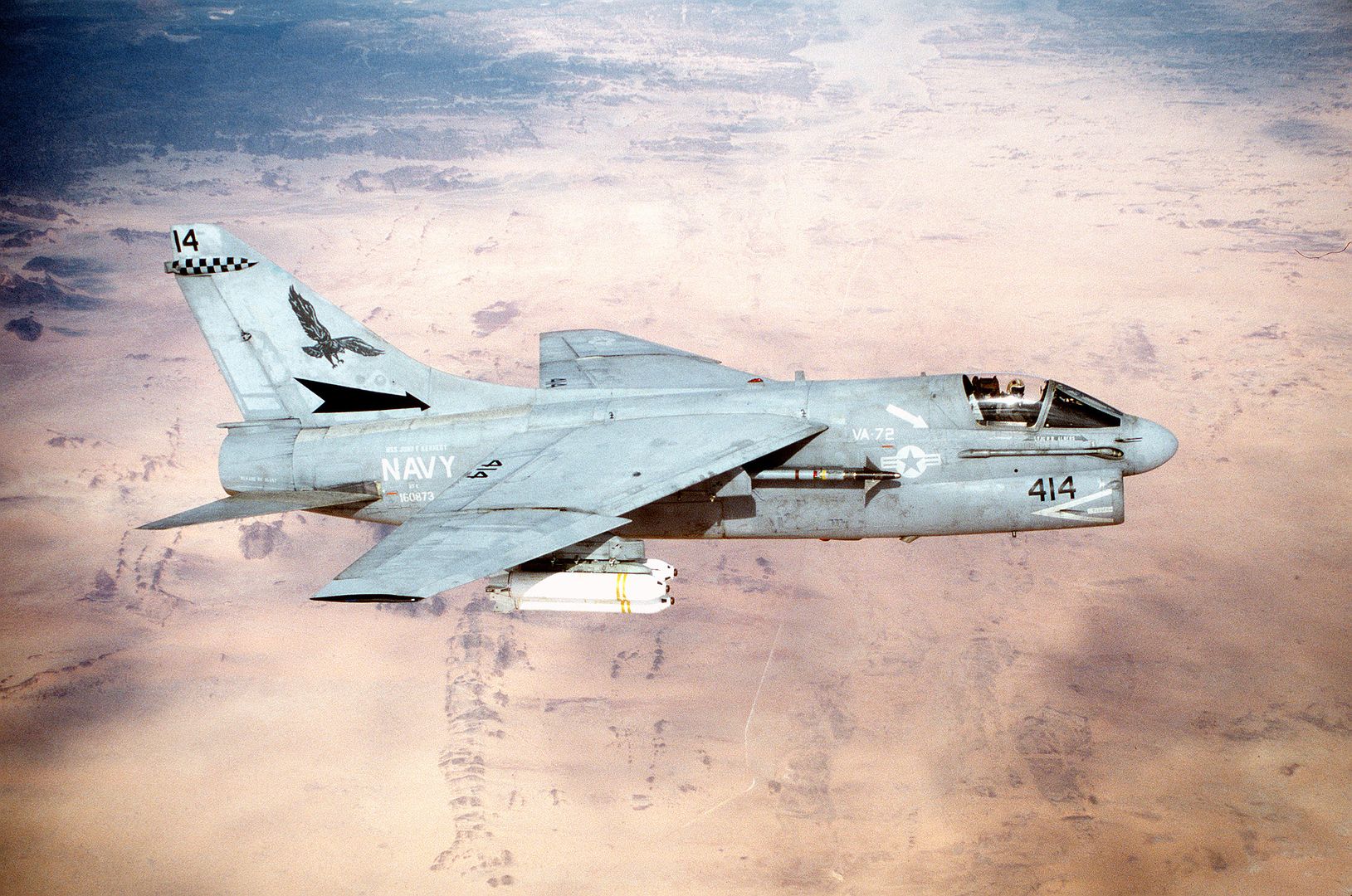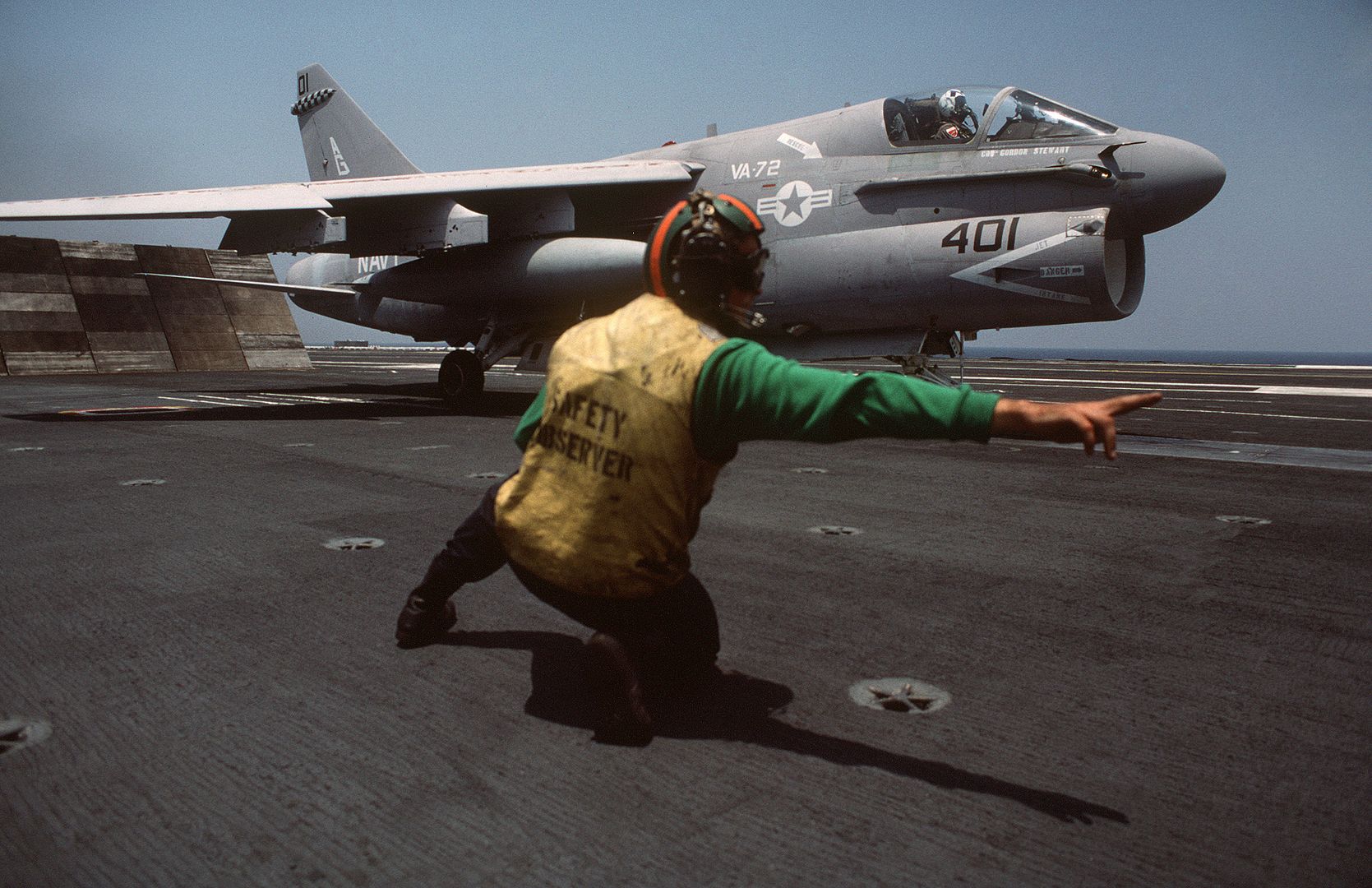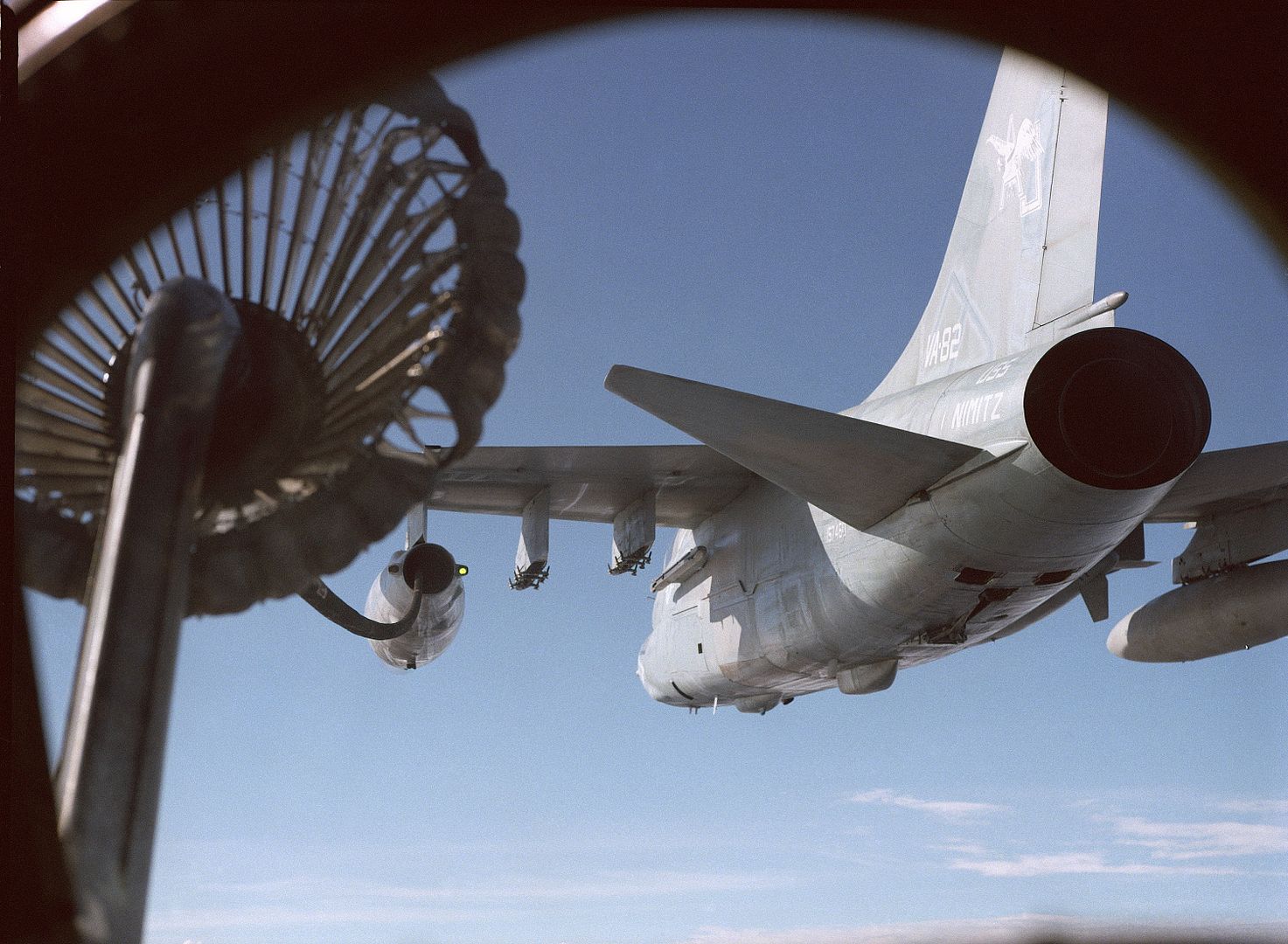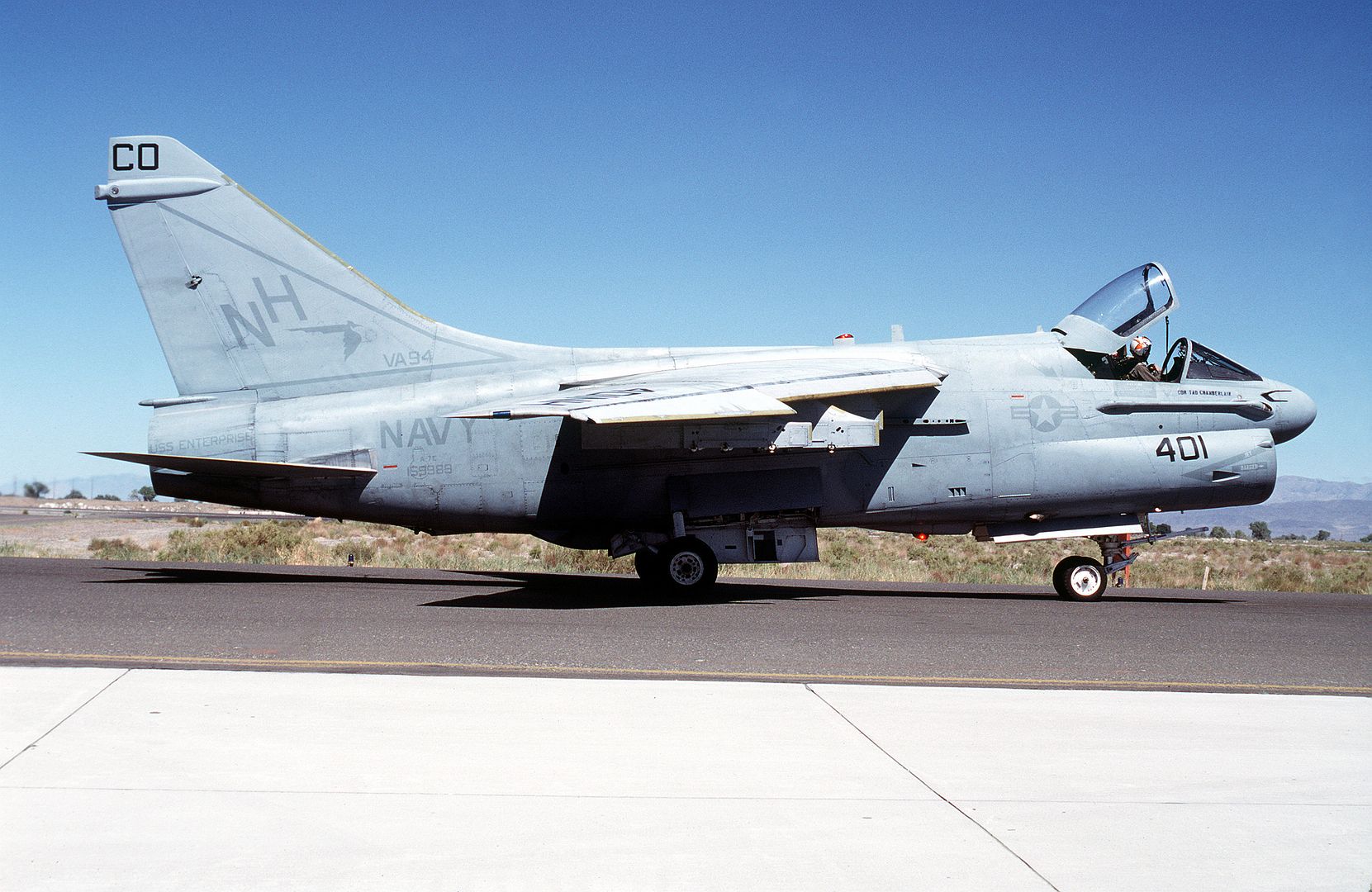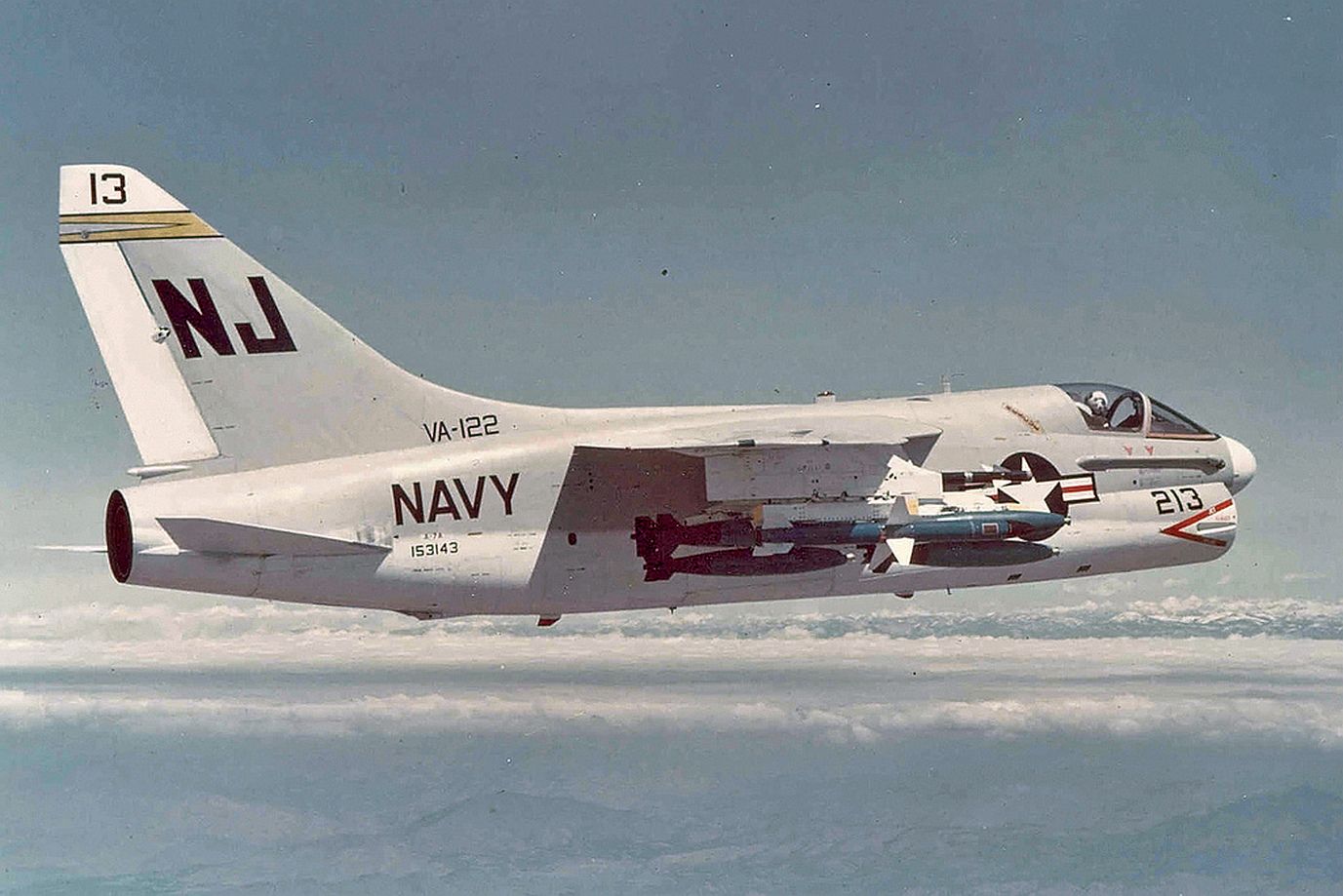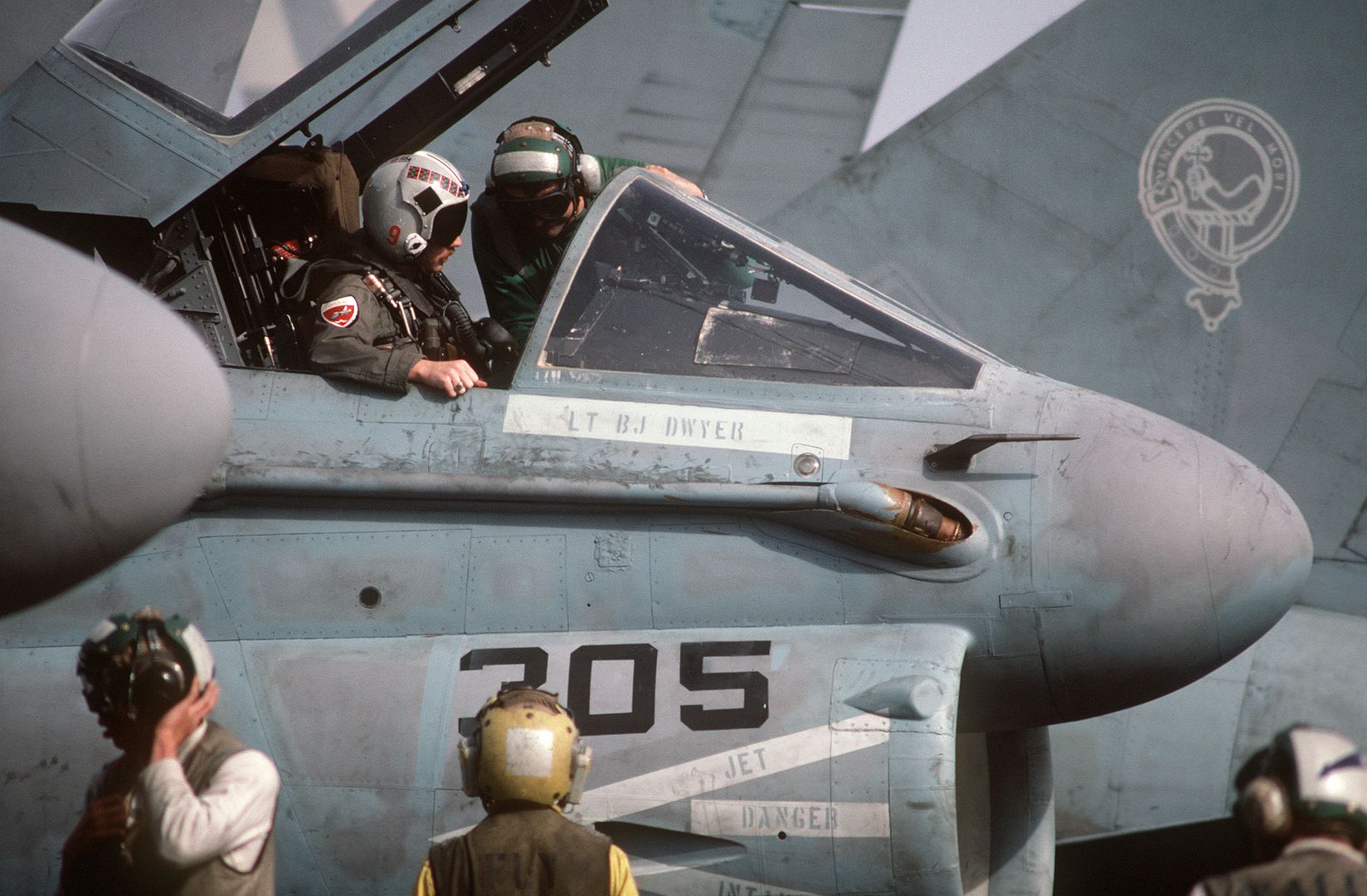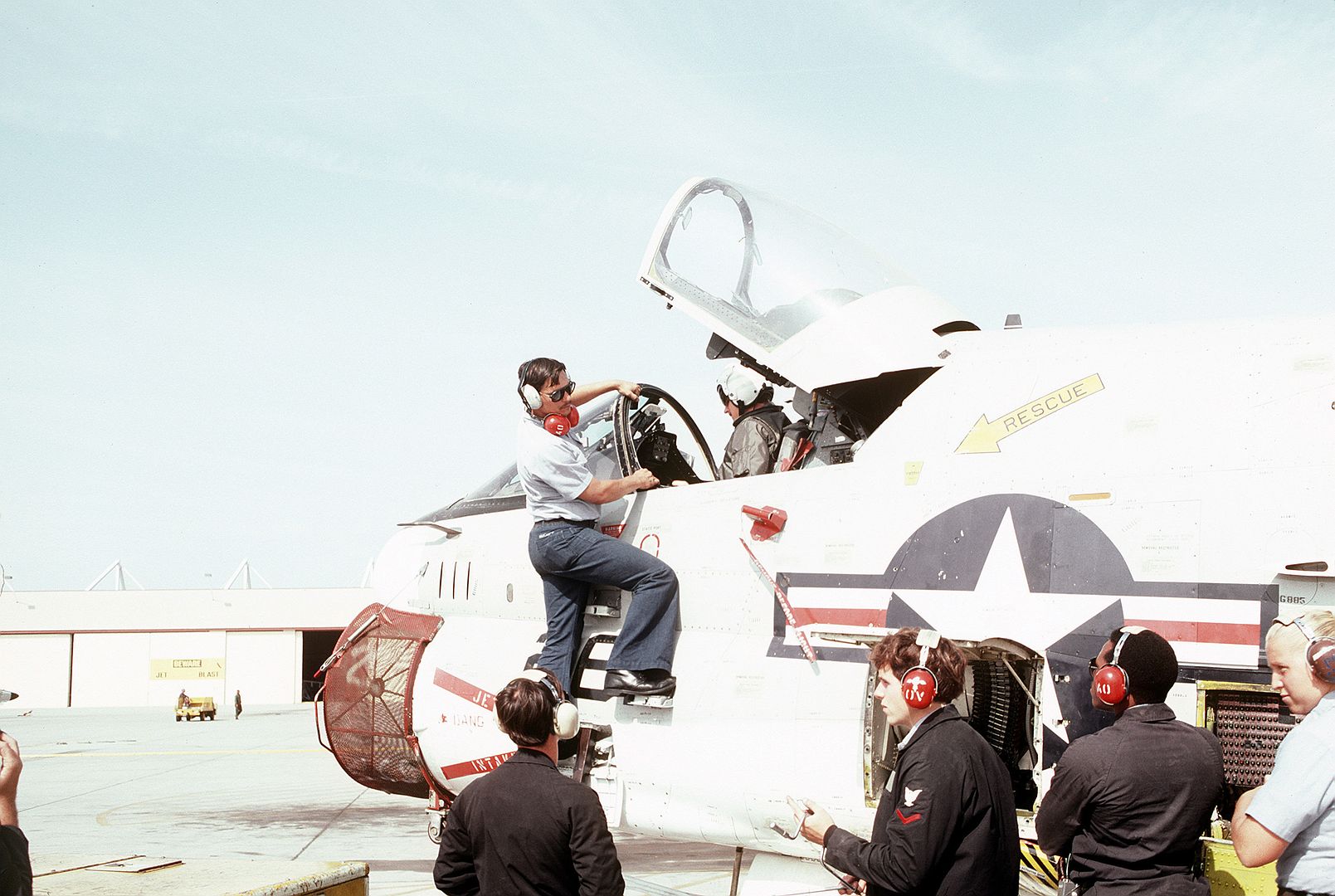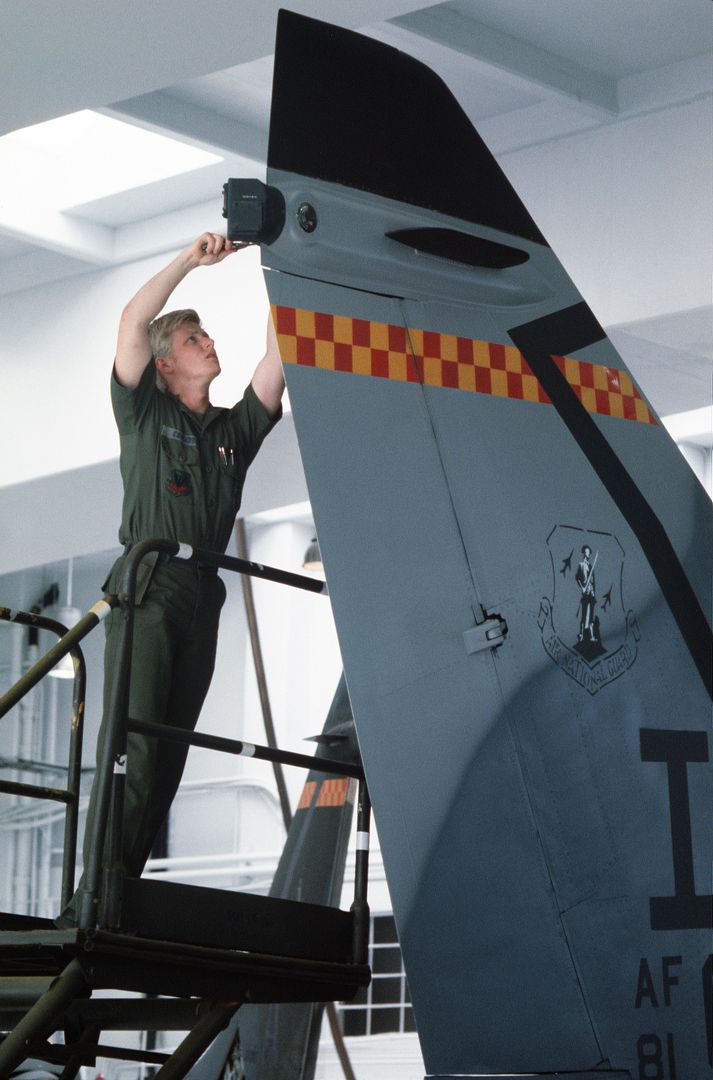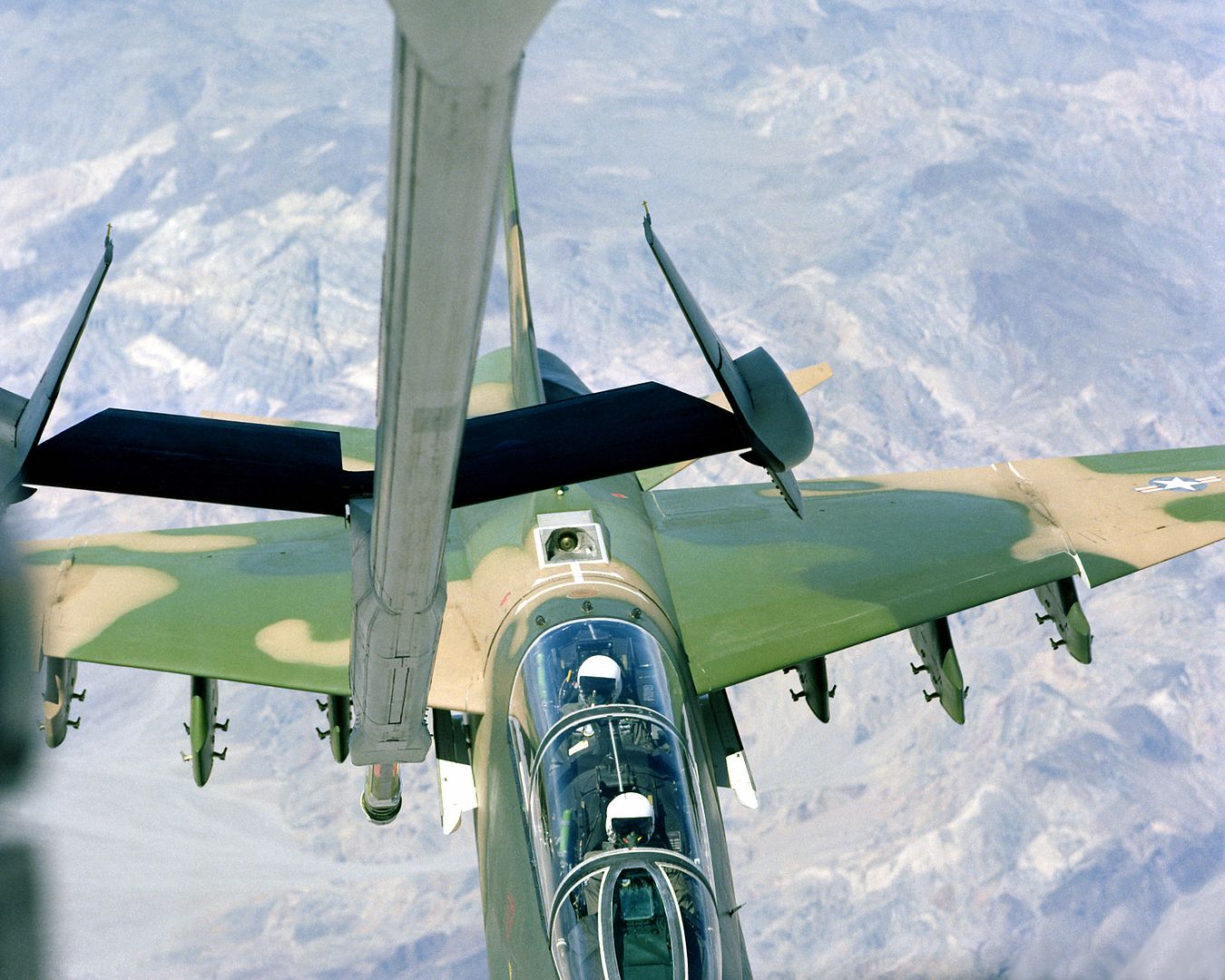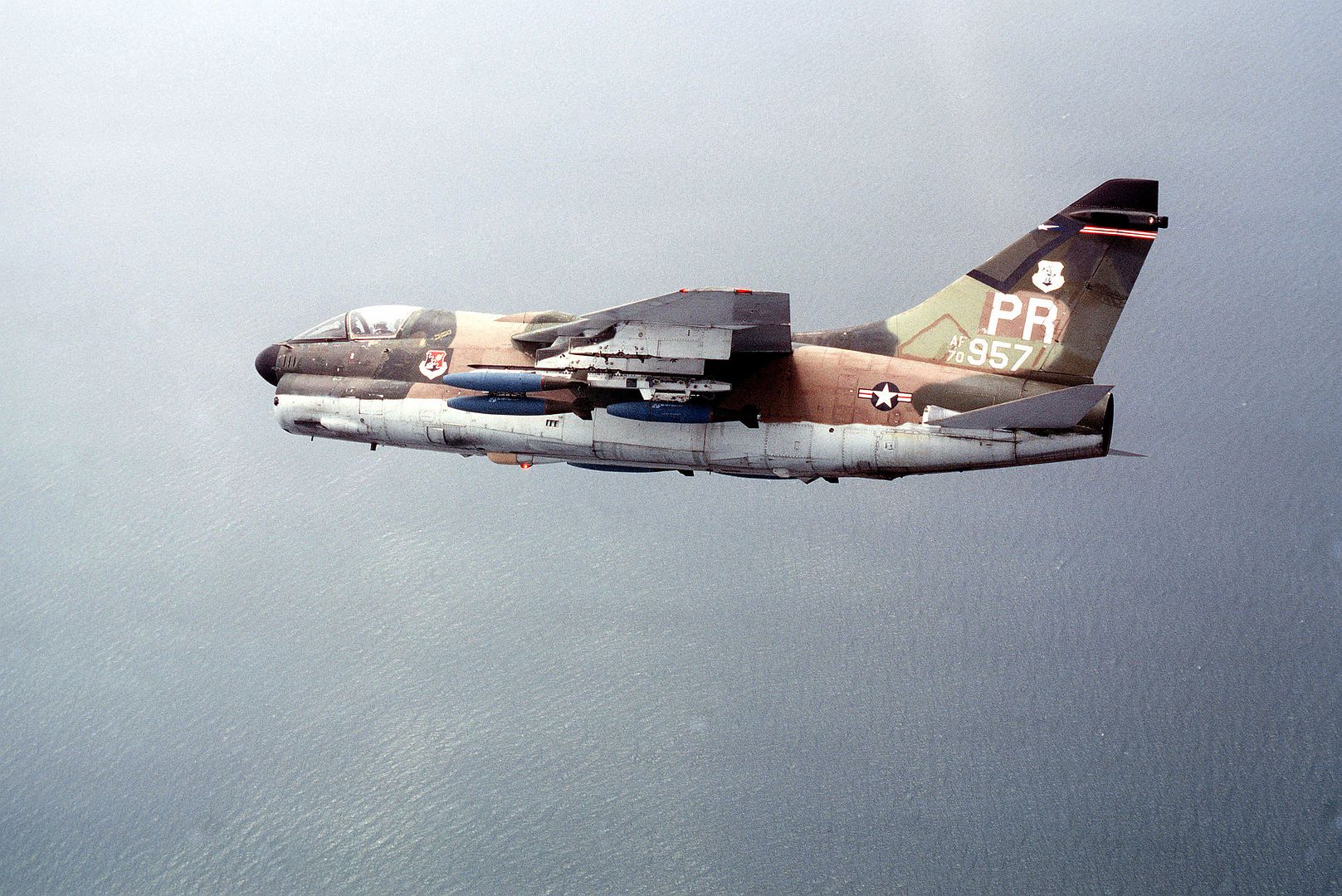Forums
- Forums
- Duggy's Reference Hangar
- USAAF / USN Library
- LTV A-7 Corsair II "SLUF" in colour
LTV A-7 Corsair II "SLUF" in colour
Post a reply
- Go to Previous topic
- Go to Next topic
- Go to Welcome
- Go to Introduce Yourself
- Go to General Discussion
- Go to Screenshots, Images and Videos
- Go to Off topic
- Go to Works in Progress
- Go to Skinning Tips / Tutorials
- Go to Skin Requests
- Go to IJAAF Library
- Go to Luftwaffe Library
- Go to RAF Library
- Go to USAAF / USN Library
- Go to Misc Library
- Go to The Ops Room
- Go to Made in Germany
- Go to Campaigns and Missions
- Go to Works in Progress
- Go to Juri's Air-Raid Shelter
- Go to Campaigns and Missions
- Go to Works in Progress
- Go to Skinpacks
- Go to External Projects Discussion
- Go to Books & Resources
-
6 years agoMon Dec 24 2018, 03:09pm
 Main AdminThe LTV A-7 Corsair II is an American carrier-capable subsonic light attack aircraft manufactured by Ling-Temco-Vought (LTV) to replace the Douglas A-4 Skyhawk. Its airframe design was a somewhat smaller version of the supersonic Vought F-8 Crusader. The Corsair II initially entered service with the United States Navy (USN) during the Vietnam War. It was later adopted by the United States Air Force (USAF), including the Air National Guard, to replace the Douglas A-1 Skyraider and North American F-100 Super Sabre. The aircraft was also exported to Greece in the 1970s, and to Portugal in the late 1980s.
Main AdminThe LTV A-7 Corsair II is an American carrier-capable subsonic light attack aircraft manufactured by Ling-Temco-Vought (LTV) to replace the Douglas A-4 Skyhawk. Its airframe design was a somewhat smaller version of the supersonic Vought F-8 Crusader. The Corsair II initially entered service with the United States Navy (USN) during the Vietnam War. It was later adopted by the United States Air Force (USAF), including the Air National Guard, to replace the Douglas A-1 Skyraider and North American F-100 Super Sabre. The aircraft was also exported to Greece in the 1970s, and to Portugal in the late 1980s.
Design and development
In 1962, the United States Navy (USN) began preliminary work on the VAX (Heavier-than-air, Attack, Experimental), a replacement for the A-4 Skyhawk with greater range and payload. Particular emphasis was placed on accurate delivery of weapons to reduce the cost per target. The requirements were finalized in 1963, announcing the VAL (Heavier-than-air, Attack, Light) competition.
To minimize costs, all proposals had to be based on existing designs. Vought, Douglas Aircraft, Grumman and North American Aviation responded. The Vought proposal was based on the successful Vought F-8 Crusader fighter, having a similar configuration, but shorter and more stubby, with a rounded nose. It was selected as the winner on 11 February 1964, and on 19 March the company received a contract for the initial batch of aircraft, designated A-7. In 1965, the aircraft received the popular name Corsair II, after Vought's highly successful F4U Corsair of World War II. (There was also a Vought O2U Corsair biplane scout and observation aircraft in the 1920s.)
The first A-7 mock-up in 1964
Compared to the F-8 fighter, the A-7 had a shorter, broader fuselage. The wing had a longer span, and the unique, variable incidence feature of the F-8 wing was omitted. To achieve the required range, the A-7 was powered by a Pratt & Whitney TF30-P-6 turbofan producing 11,345 lbf (50.5 kN) of thrust, the same innovative combat turbofan produced for the General Dynamics F-111 Aardvark and early Grumman F-14 Tomcats, but without the afterburner needed for supersonic speeds.
The aircraft was fitted with an AN/APQ-116 radar, later followed by the AN/APQ-126, which was integrated into the ILAAS digital navigation system. The radar also fed a digital weapons computer which made possible accurate delivery of bombs from a greater stand-off distance, greatly improving survivability compared with faster platforms such as the McDonnell Douglas F-4 Phantom II. It was the first U.S. aircraft to have a modern head-up display, (made by Marconi-Elliott), now a standard instrument which displayed information such as dive angle, airspeed, altitude, drift and aiming reticle. The integrated navigation system allowed for another innovation ? the projected map display system (PMDS) which accurately showed aircraft position on two different map scales.
The A-7 had a fast and smooth development. The YA-7A made its first flight on 27 September 1965, and began to enter Navy squadron service late in 1966. The first Navy A-7 squadrons reached operational status on 1 February 1967, and began combat operations over Vietnam in December of that year.
The A-7 offered a plethora of cutting-edge avionics compared to contemporary aircraft. This included data link capabilities that, among other features, provided fully "hands-off" carrier landing capability when used in conjunction with its approach power compensator (APC) or auto throttle. Other notable and highly advanced equipment was a projected map display located just below the radar scope. The map display was slaved to the inertial navigation system and provided a high-resolution map image of the aircraft's position superimposed over TPC/JNC charts. Moreover, when slaved to the all-axis auto pilot, the inertial navigation system could fly the aircraft "hands off" to up to nine individual waypoints. Typical inertial drift was minimal for newly manufactured models and the inertial measurement system accepted fly over, radar, and TACAN updates.
Operational history
Initial operational basing/homeporting for USN A-7 squadrons was at NAS Cecil Field, Florida for Atlantic Fleet units and NAS Lemoore, California for Pacific Fleet units. This was in keeping with the role of these bases in already hosting the A-4 Skyhawk attack squadrons that would eventually transition to the A-7.
From 1967 to 1971, a total of 27 US Navy squadrons took delivery of four different A-7A/B/C/E models. The Vought plant in Dallas, Texas employed up to 35,000 workers who turned out one aircraft a day for several years to support the navy's carrier-based needs for Vietnam and SE Asia and commitments to NATO in Europe. In 1974, when USS Midway became the first Forward Deployed Naval Force (FDNF) aircraft carrier to be homeported in Yokosuka, Japan, two A-7A squadrons assigned to Carrier Air Wing Five (CVW-5) were concurrently homeported at NAF Atsugi, Japan. In 1976, these squadrons (VA-93 and VA-56) finally transitioned to the much more advanced A-7E model. Six Naval Reserve attack squadrons would also eventually transition to the A-7, operating from NAS Cecil Field, Florida; NAS Atlanta/Dobbins ARB, Georgia; NAS New Orleans, Louisiana; NAS Alameda, California and NAS Point Mugu, California. An additional active duty squadron stood up in the 1980s, Tactical Electronic Warfare Squadron 34 (VAQ-34) at NAS Point Mugu, operating twin-seat TA-7C and EA-7L aircraft with both a pilot and a naval flight officer in an adversary electronic warfare role.
Pilots of the early A-7s lauded the aircraft for general ease of flying (with the exceptions of poor stability on crosswind landings and miserable stopping performance on wet runways with an inoperative anti-skid braking system) and excellent forward visibility but noted a lack of engine thrust. This was addressed with A-7B and more thoroughly with A-7D/E. The turbofan engine provided a dramatic increase in fuel efficiency compared with earlier turbojets ? the A-7D was said to have specific fuel consumption one sixth that of an F-100 Super Sabre at equivalent thrust. An A-7D carrying 12 x 500 lb (227 kg) bombs at 480 mph (775 km/h) at 33,000 ft (10,000 m) used only 3,350 lb (1,500 kg) of fuel per hour. Typical fuel consumption at mission retrograde during aircraft carrier recovery was approximately 30 pounds per minute compared to 100+ pounds per minute for the Phantom F-4J/N series. The A-7 Corsair II was tagged with the nickname "SLUF" ("Short Little Ugly Fucker") by pilots.
Southeast Asia carrier use
In Vietnam, the hot, humid air robbed even the upgraded A-7D and A-7E of power. Takeoff rolls were lengthy, and fully armed aircraft struggled to reach 500 mph (800 km/h). For A-7A aircraft, high density altitude and maximum weight runway takeoffs often necessitated a "low transition", where the aircraft was intentionally held in "ground effect" a few feet off the runway during gear retraction, and as much as a 10-mile (16 km) departure at treetop altitude before reaching a safe flap retraction speed. (A-7A wing flap systems were either fully extended or fully retracted. The A-7A flap handle did not have the microswitch feature of later models that permitted the flaps to be slowly raised by several degrees per tap of the flap handle as airspeed slowly increased during max-weight takeoffs.)
Carrier catapult launches at maximum weight under these performance-robbing conditions were not significantly better and were characterized by the aircraft decelerating by as much as 20 knots (37 km/h) immediately after launch. As a result, A-7A units operated their aircraft 4,000 pounds (1,814 kg) below the rated maximum takeoff weight for the A-7E.
In a sortie against the Thanh H?a Bridge on 6 October 1972, four A-7Cs from VA-82 successfully delivered 8,000 lbs of high explosives with two aircraft carrying two 2,000 lb (910 kg) Walleyes, while two others also carried 2,000 lbs in Mk 84 GP bombs. In a simultaneous attack, the center piling on the bridge's west side was hit and broke the span in half. After this, the Thanh Hoa bridge was considered permanently destroyed and removed from the target list.
A total of 98 USN A-7 Corsairs were lost during the war.
United States Air Force A-7D
The United States Army has not been permitted to operate fixed-wing combat aircraft since the establishment of an independent United States Air Force (USAF) in 1947. To meet its need for close air support of its troops in South Vietnam, the Army pressured the Air Force to procure a specialized subsonic close air support fixed-wing aircraft that would suit its needs better than the general-purpose supersonic aircraft that the USAF preferred.
The Vought A-7 seemed to be a relatively quick and inexpensive way to satisfy this need. However, the USAF was initially reluctant to take on yet another Navy-designed aircraft, but Secretary of Defense Robert McNamara was insistent. On 5 November 1965, Secretary of the Air Force Harold Brown and USAF Chief of Staff General John P. McConnell announced that they had decided to order a version of the Corsair II, designated A-7D, for the Tactical Air Command.
The A-7D differed from the Navy's Corsair II in several ways. For one, the Air Force insisted on significantly more power for its Corsair II version, and it selected the Allison TF41-A-1 turbofan engine, which was a license-built version of the Rolls-Royce Spey. It offered a thrust of 14,500 pounds, over 2000 pounds greater than that of the TF30 that powered the Navy's Corsair IIs. Other changes included a head-up display, a new avionics package, and an M61A1 rotary cannon in place of the two single-barreled 20-mm cannon. Also included was a computerized navigation/weapons delivery system with AN/APQ-126 radar and a head-up display.
Two YA-7D prototypes were completed with TF30-P-6 engines, and the first of these flew on 6 April 1968. The first Spey-powered A-7D (67-14854) flew for the first time on 26 September 1968. The seventeenth production aircraft introduced a provision for boom flight refueling in place of the Navy's probe/drogue system, with the boom receptacle being on the top of the fuselage behind the cockpit and offset to port.
The A-7D first entered service in 1970 with the 57th Fighter Weapons Wing at Luke AFB Arizona, and the 354th Tactical Fighter Wing at Myrtle Beach AFB, South Carolina was equipped with four squadrons of A-7Ds by 1972; the 355th TFW at Davis-Monthan AFB was equipped with four squadrons in 1972, and in 1973, the 23d TFW at England AFB, Louisiana was fully equipped with A-7Ds.
The 354th TFW first deployed two squadrons of A-7Ds to Korat Royal Thai AFB, Thailand in September 1972 as part of Operation Cornet Dancer, The A-7Ds were quickly assigned the "Sandy mission" of providing air cover for Combat Search and Rescue missions of downed pilots.
Taking over from Douglas A-1 Skyraiders (and adopting their call sign of "Sandy"), the A-7's higher speed was somewhat detrimental for escorting the helicopters but the aircraft's high endurance and durability were an asset and it performed admirably.
On 18 November 1972, Major Colin A. Clarke led a successful CSAR mission near Thanh Hoa to rescue a downed Republic F-105 Thunderchief crew. The mission lasted a total of 8.8 hours during which Clarke and his wingman took a number of hits from 0.51 cal (12.7 mm) anti-aircraft fire. For his actions in coordinating the rescue, Clarke was awarded the Air Force Cross, the USAF's second-highest decoration for valor, and his A-7D (AF Serial No. 70-0970) was eventually placed on display on 31 January 1992 at the National Museum of the United States Air Force at Wright-Patterson AFB, Ohio.
With the end of US involvement in South Vietnam, the 354th TFW, deployed at Korat, began flying combat sorties in Cambodia to support the Lon Nol government in support of Khmer National Armed Forces against the Khmer Rouge. Rotational deployments began to Korat from the 355th TFW and 23d TFW, with pilots and support personnel beginning six-months deployment cycles. In March 1973, the 354th transferred a squadron of A-7Ds to the 388th TFW, the host wing at Korat RTAFB at the time, which re-established the 3d Tactical Fighter Squadron and created a permanent USAF A-7D presence in Southeast Asia. A-7Ds from both wings stationed at Korat engaged in combat operations in Cambodia until 15 August 1973 when an A-7D of the deployed 353d TFS/354th TFW carried out the last air support mission. In March 1974, the 354th TFW transferred several more aircraft to the 3d TFS prior to its return to Myrtle Beach AFB.
The USAF A-7D flew a total of 12,928 combat sorties during the war with only six losses[19] ? the lowest of any U.S. fighter in the theater. The aircraft was second only to Boeing B-52 Stratofortress in the amount of ordnance dropped on Hanoi and dropped more bombs per sortie with greater accuracy than any other U.S. attack aircraft.
A-7E development
The Navy was sufficiently impressed with the increased power offered by the A-7D Spey engine used by the Air Force, and decided to use this engine for its own version of the Corsair II. The designation A-7E was assigned, and this version was to succeed the A-7B in production. However, there were delays in the deliveries of the TF41-A-2 engine specified for the A-7E, so the first 67 aircraft of the order were delivered with the TF30-P-5 engine. These aircraft had all of the other improvements planned for the A-7E, including the improved avionics and the M61 rotary cannon, and were re-designated A-7C after delivery.
The first Spey-powered A-7E flew for the first time on 9 March 1969. The A-7E differed from the USAF A-7D in retaining the probe-and-drogue midair refueling system of the earlier A-7A/B. It entered service in Southeast Asia in May 1970 with VA-146 and VA-147 deployed aboard USS America. The A-7E participated in numerous close-air support missions over both North and South Vietnam, the A-7E's state-of-the-art bombing and navigation system being particularly reliable and accurate. Most air wings operating Douglas A-4 Skyhawks and early A-7s were re-equipped with A-7Es. The A-7E participated in the mining of Haiphong harbor in 1972, and played a vital role in Operations Linebacker I and Linebacker II that led up to the formal end of US involvement in the Vietnam War on 24 January 1973.
On 15 May 1975, A-7E aircraft operating from USS Coral Sea, in conjunction with A-7D aircraft assigned to the 3d TFS at Korat RTAFB, provided air cover in what is considered the last battle of the Vietnam War, the recovery of SS Mayag?ez after it was hijacked by Khmer Rouge gunboats. By the time the Mayaguez incident was over, three USAF Sikorsky CH-53 Sea Stallion helicopters had been shot down, two airmen, 11 Marines and two Navy Corpsmen had been killed in action and a further three Marines were missing in action.
Air National Guard
With the pullout of the USAF from its Thailand bases in late 1975, the A-7Ds stationed at Korat initially went to Clark AB, Philippines. The 3d TFS transitioned from its Corsairs to the McDonnell Douglas F-4E Phantom II and remained at Clark. The A-7Ds were returned to the United States where they were reassigned to several Air National Guard squadrons.
With the end of the Vietnam War, the Air Force began to transfer its active-duty A-7D aircraft to Air National Guard units beginning in 1974. The Corsairs had been, in a sense, a forced acquisition by the Air Force in the late 1960s, and the inter-service rivalry of flying a Navy aircraft had led, beginning about 1970, to the development of its own Close Air Support aircraft. In 1974, selection of the Fairchild Republic A-10 Thunderbolt II was made as the replacement for the A-7D. The first A-10As were received by the 354th TFW in 1977 at Myrtle Beach AFB; the 355th TFW at Davis-Monthan AFB began replacing its A-7Ds in 1978, and the 23d TFW at England AFB in 1979. As the A-10s were received, the A-7Ds were transferred from the USAF to the National Guard Bureau for subsequent re-allocation. By 1981, when the 23d TFW sent its last A-7Ds to Tonopah Test Range Airport, Nevada for clandestine use in the Lockheed F-117 Nighthawk development program, fifteen ANG squadrons were equipped with the A-7D Corsair II.
However, Congressional decisions added additional funding to the DOD FY 1975 and FY 1976 budgets for the procurement of additional A-7Ds, primarily to keep the LTV production line in Dallas open and the workers employed in the wake of post-Vietnam DOD procurement reductions. As a result of these unplanned acquisitions, the Air Force assigned these new aircraft (all with 1975 tail numbers) to the Arizona Air National Guard 152nd Tactical Fighter Squadron at Tucson, which operated the Air National Guard transition training school for Corsair II pilots. In 1978, a two-seat A-7 trainer was developed by LTV for the Air Force, designated the A-7K. One prototype aircraft was built by modifying an existing A-7D airframe, however production A-7Ks were new builds with 1979 and 1980 tail numbers. The A-7K was a fully combat capable aircraft as well as a dual-control training aircraft. Most of the A-7K trainers went to the transition school at Tucson, with the squadrons' A-7Ds being re-distributed to other ANG squadrons. However all ANG squadrons were assigned an A-7K trainer as well as their complement of A-7Ds.
During the post-Vietnam era, the Air National Guard frequently deployed its Corsairs on annual operational exercises. Deployments were made to NATO and USAFE bases in West Germany and Denmark as part of training exercises along with the USAREUR Reforger training exercises.
Beginning in 1974, active-duty squadrons from Myrtle Beach, England and Davis-Monthan Air Force Bases began deployments of A-7Ds to Howard AFB, Panama to train with Army and Naval forces defending the Panama Canal. These deployments, named "Cornet Cove" generally were of ninety (90) days, and were rotated among squadrons of the three wings in the United States. Beginning in 1977, with the phaseout of the A-7D with active-duty units, the Air National Guard began taking over this mission. In December 1989, the South Dakota 175th Tactical Fighter Squadron and Ohio 112th Tactical Fighter Squadron were at Howard AFB on a Coronet Cove deployment when President George H.W. Bush announced Operation Just Cause, the United States Invasion of Panama. The ANG squadrons participated in the invasion, flying 34 combat missions, completing 34 sorties, expended 71.7 flying hours and expended 2,715 rounds of ordnance.
On 12 January 1981, in the 1981 Luis Mu?oz Mar?n International Airport attack, 10 A-7Ds of the 198th Tactical Fighter Squadron, Puerto Rico Air National Guard were destroyed or damaged in a terrorist attack by the Boricua Popular Army at Muniz Air National Guard Base in the largest attack ever on an American military station since the Vietnam War. This terrorist attack was largely unreported due to the Iran hostage crisis at the time.
Grenada and Lebanon
Navy A-7E squadrons VA-15 and VA-87, from USS Independence, provided close air support during the Invasion of Grenada, codenamed Operation Urgent Fury, in October 1983.
Navy A-7s also provided air support during the U.S. mission in Lebanon in 1983. An A-7 and an A-6 Intruder were shot down by Syrian surface-to-air missiles (SAM) on 4 December 1983. The A-7 pilot, Commander Edward Andrews, managed to guide his failing Corsair over coastal waters before ejecting; he was rescued by a Lebanese fishing boat and safely returned to the U.S. Marines.
Libya
On 24 March 1986, during the Gulf of Sidra dispute with Libya, Libyan air defense operators launched SA-5 missiles at two Fighter Squadron 102 (VF-102) Grumman F-14 Tomcats from USS America that were orbiting in international air space on a Combat Air Patrol (CAP) station. A-7s operating from USS Saratoga responded by launching the first AGM-88 HARM missiles ever used in combat. On the next day, A-6s attacked Libyan warships approaching the US fleet, while A-7s again launched HARM missiles against Libyan SAM sites.
In April 1986, navy Sixth Fleet A-7Es from VA-72 and VA-46 embarked on board USS America also participated in Operation El Dorado Canyon, the retaliatory attack on Libya, using HARM and Shrike anti-radar missiles to protect the naval strike force from SAMs.
Operations Desert Shield and Desert Storm
While USAF A-7s stayed home in favor of A-10s, the USN deployed two of its last A-7E squadrons to Operation Desert Shield in August 1990 aboard USS John F. Kennedy, the only carrier of six deployed to Desert Storm to operate the A-7. The navy squadrons VA-46 and VA-72 made the last combat sorties of the A-7 in Operation Desert Storm flying from the Red Sea to targets throughout Iraq. The A-7 was used both day and night to attack a wide range of heavily defended deep interdiction targets in Iraq as well as "kill boxes" (geographically defined kill zones) in Kuwait, employing a variety of weapons including precision-guided munitions (PGMs), such as the TV-guided Walleye glide bomb, unguided general purpose bombs, and High Speed Anti-Radiation missiles (HARM). The A-7 was also used as a tanker in numerous in-flight refueling missions.
Use in F-117 development
The 4450th Tactical Group stationed at Nellis AFB, Nevada had the distinction of being the last active USAF unit to operate the A-7 Corsair II. The mission of the 4450th TG was the operational development of the Lockheed F-117 Nighthawk, and the unit needed a surrogate aircraft for pilot training and practice. A-7Ds and A-7Ks were obtained from various active duty and air national guard squadrons and were assigned initially to the "(P)" or "Provisional" unit of the 4450th Tactical Group, redesignated the 4451st Tactical Squadron in January 1983.
The A-7s were used as a deception and training aircraft by the group between 1981 and 1989. It was selected because it demanded a similar pilot workload expected in the F-117A, was single seat, and many of the F-117A pilots had F-4 or F-111 backgrounds. A-7s were used for pilot training before any F-117As had been delivered, to bring all pilots to a common flight training base line. Later, the A-7s were used as chase planes on F-117A tests and other weapon tests at the Nellis Range.
A-7D-5-CV AF Serial No. 69-6241 of the 4451st Test Squadron / 4450th Tactical Group at Nellis AFB, Nevada in 1984
A-7 flight operations began in June 1981 concurrent with the very first YF-117A flights. The A-7s wore a unique "LV" tailcode (for Las Vegas) and had a dark purple/black paint motif. The A-7s were based officially at Nellis Air Force Base and were maintained by the 4450th Maintenance Squadron. In addition to providing an excuse for the 4450th's existence and activities, the A-7s were also used to maintain pilot currency, particularly in the early stages when very few production F-117As were available. The pilots learned to fly chase on F-117A test and training flights, perform practice covert deployments, and practice any other purpose that could not be accomplished using F-117As, given the tight restrictions imposed on all F-117A operations.
Some A-7s operated from the Tonopah Test Range Airport, about 30 miles (48 km) southeast of Tonopah, Nevada where the F-117s were being operationally tested. As a deception operation, care was taken to ensure that F-117As were never left parked outside aircraft hangars during daylight hours. However, A-7s were deliberately and routinely left outside hangars for the benefit of any orbiting Soviet spy satellites. Soviet intelligence agencies examining spy satellite imagery of the base would undoubtedly notice the A-7s parked on the Tonopah flight line, and would not be particularly interested. The intention of this deception was to convince the Soviets that Tonopah operated nothing more exciting than some obsolete A-7 Corsairs. The cover story to the public was that the A-7s were flying "radar calibration missions" out of Tonopah. Also, in order to help maintain the deception, about five or six A-7Ds were deployed to South Korea in 1984 and 1988. In South Korea they trained with the Army for about a month in Close Air Support operations. It appeared to the Russians that it was a real squadron with a combat mission because the aircraft could be seen having munitions loaded and performing training missions.
EA-7L pilots of VAQ-34 at Elmendorf AB, 1987
There were approximately 20 A-7D aircraft used in developing the F-117, including several two-seat A-7K trainers. In January 1989, three months after the USAF admitted the F-117A existed, the A-7s were retired to AMARC and were replaced by AT-38B Talons as training aircraft and the 4451st TS was deactivated.
Training and retirement
Pilots quipped that the Corsair "is not very fast, but it sure is slow." For dissimilar air combat training (DACT), and aerial demonstrations by the Blue Angels, the Navy would choose the more nimble Douglas A-4 Skyhawk as a subsonic maneuvering platform, as some considered the A-7 to be inadequate in air combat, even though it was highly maneuverable. While some questioned its air combat capability it was widely regarded as a highly successful attack aircraft, partly by virtue of being a stable bombing platform. Despite this, the Marine Corps also rejected the Corsair, opting instead for the V/STOL (Vertical/Short Take Off or Landing) AV-8 Harrier as its light attack aircraft to replace its A-4F/M Skyhawks.
Greece's Hellenic Air Force ordered sixty new A-7H aircraft in 1974 and three TA-7Hs in 1980; and received sixty-two surplus A-7Es and TA-7Cs from the USN after the Gulf War. The Hellenic Air Force's 336th Bomber Squadron was the last unit to use the aircraft.
The sale of A-7s to Pakistan was not approved due to US opposition to its nuclear program.
General Dynamics F-16 Fighting Falcons began replacing the Air National Guard Corsairs beginning in the late 1980s and the last were retired in 1993 by the units at Rickenbacker Air National Guard Base, Ohio; Des Moines Air National Guard Base, Iowa; Tulsa Air National Guard Base, Oklahoma; and Springfield Air National Guard Base, Ohio.
USN A-7 Corsairs began being phased out of the fleet during the mid-1980s with the arrival of the McDonnell Douglas F/A-18 Hornet. A-7 squadrons of the United States Navy Reserve transitioned concurrent with (but prior to the completion of) all Regular Navy squadrons. The last Navy A-7s were retired by the last fleet operational squadrons (VA-46 and VA-72) in May 1991 shortly after their return from Operation Desert Storm. By the end of 1998, with the exception of some airframes used as static displays, all US A-7s were disposed of by the Aerospace Maintenance and Regeneration Center (AMARC) at Davis-Monthan AFB, Arizona.
Some of these surplus aircraft were passed to Greece, Thailand and Portugal. The last Portuguese Air Force A-7Ps were retired in 2007 after 26 years. Greece retired its A-7s in 2014. The Corsair II served for 49 years.
General characteristics A-7E
Crew: 1
Length: 46 ft 2 in (14.06 m)
Wingspan: 38 ft 9 in (11.8 m)
Width: 23 ft 9 in (7.24 m) wings folded
Height: 16 ft 1 in (4.9 m)
Wing area: 374.9 sq ft (34.83 m2)
Airfoil: NACA 65A007 root and tip
Empty weight: 19,127 lb (8,676 kg)
Max takeoff weight: 41,998 lb (19,050 kg) overload condition.
Fuel capacity: 1,338 US gal (5,060 l; 1,114 imp gal) (10,200 lb (4,600 kg)) internal
Powerplant: 1 ? Allison TF41-A-2 non-afterburning turbofan engine, 15,000 lbf (66.7 kN) thrust
Performance
Maximum speed: 600 kn (690 mph; 1,111 km/h) at Sea level
562 kn (1,041 km/h; 647 mph) at 5,000 ft (1,524.0 m) with 12x Mk82 bombs
595 kn (1,102 km/h; 685 mph) at 5,000 ft (1,524.0 m) after dropping bombs
Range: 1,070 nmi; 1,231 mi (1,981 km) maximum internal fuel
Ferry range: 1,342 nmi; 1,544 mi (2,485 km) with maximum internal and external fuel
Service ceiling: 42,000 ft (13,000 m)
Wing loading: 77.4 lb/sq ft (378 kg/m2)
Thrust/weight: 0.50
Sustained maneuvering performance: 5,300 ft (1,615.4 m) turning radius at 4.3g and 500 kn (930 km/h; 580 mph) at an All Up Weight (AUW) of 28,765 lb (13,048 kg)
Take-off run: 1,705 ft (519.7 m) at 42,000 lb (19,000 kg)
Text from Wikki
As usual right click & save as for details.


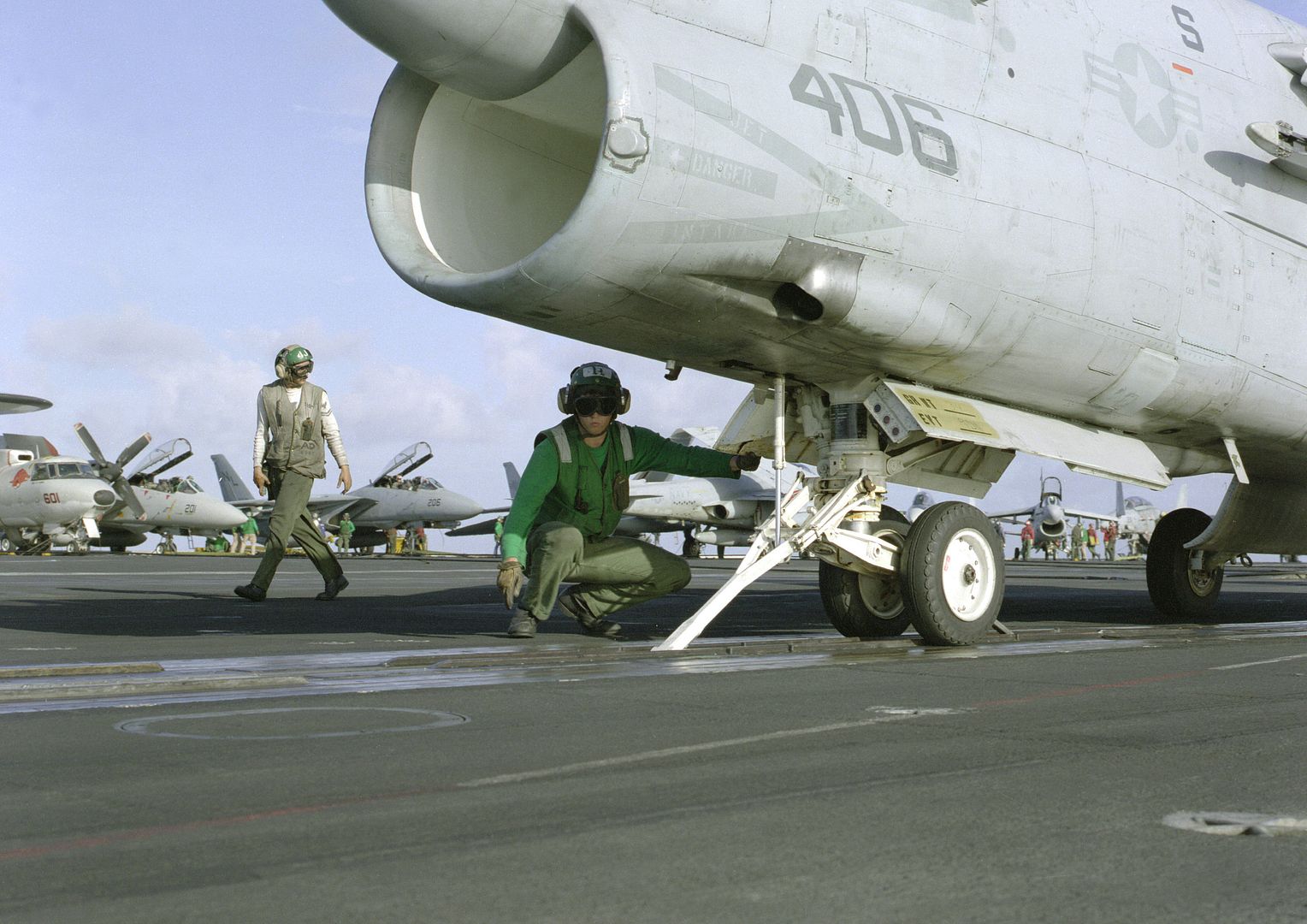


















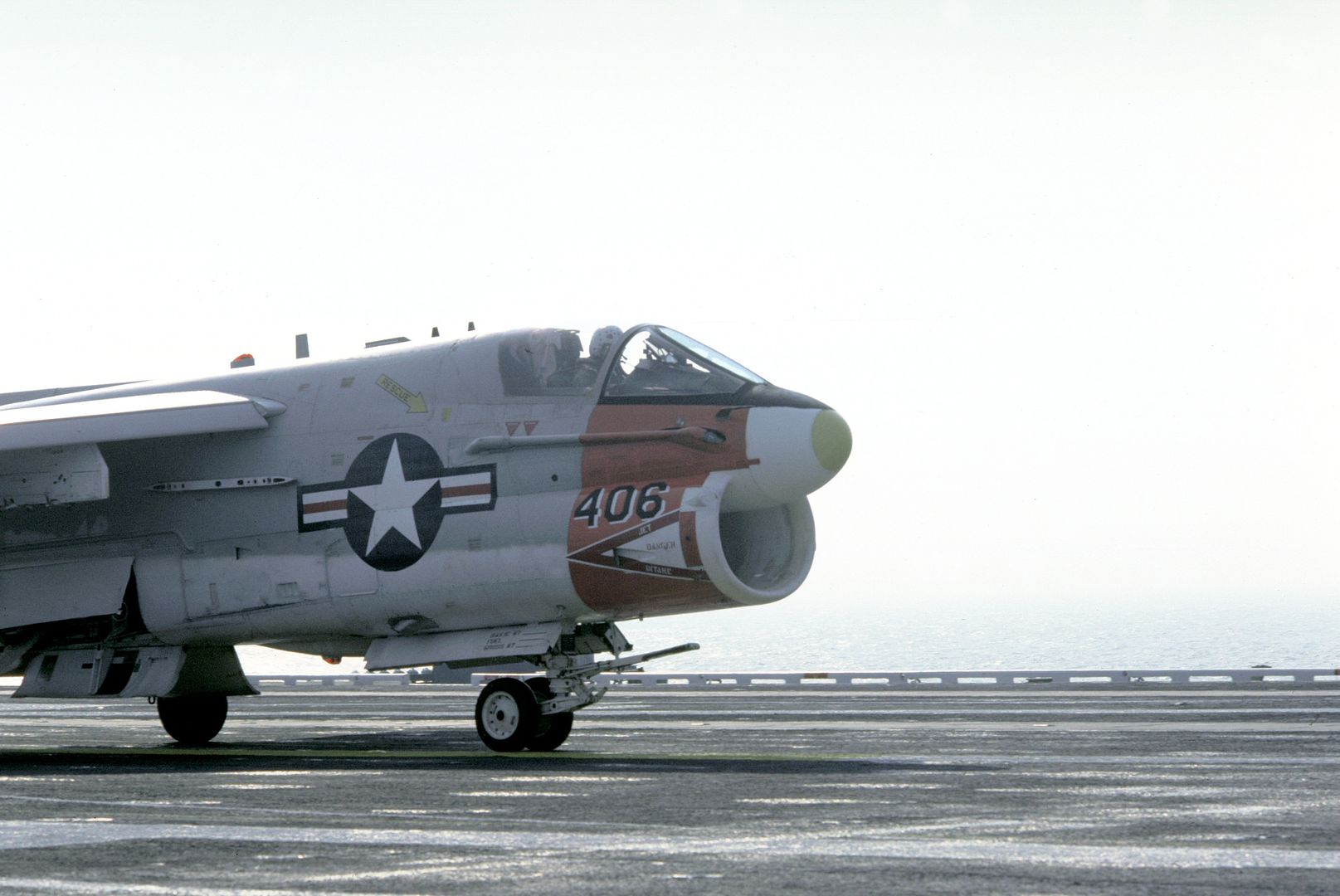


-
 Main Admin
Main Admin -
 Main Admin
Main Admin -
 Main Admin
Main Admin -
 Main Admin
Main Admin -
 Main Admin
Main Admin -
 Main Admin
Main Admin -
 Main Admin
Main Admin -
 Main Admin
Main Admin -
 Main Admin
Main Admin
Post a reply
- Go to Previous topic
- Go to Next topic
- Go to Welcome
- Go to Introduce Yourself
- Go to General Discussion
- Go to Screenshots, Images and Videos
- Go to Off topic
- Go to Works in Progress
- Go to Skinning Tips / Tutorials
- Go to Skin Requests
- Go to IJAAF Library
- Go to Luftwaffe Library
- Go to RAF Library
- Go to USAAF / USN Library
- Go to Misc Library
- Go to The Ops Room
- Go to Made in Germany
- Go to Campaigns and Missions
- Go to Works in Progress
- Go to Juri's Air-Raid Shelter
- Go to Campaigns and Missions
- Go to Works in Progress
- Go to Skinpacks
- Go to External Projects Discussion
- Go to Books & Resources








